





















































































































































































As you’ll see in the pages that follow, the luxury real estate market around the world is active and strong, often reaching new heights in terms of prices, sales numbers and newly anointed in-demand locations. While some of the frenzy of the past few years’ real estate market has quieted, high-end migration is still happening. Wealthy buyers are more flexible about where they’ll live, as long as the home itself, its setting and its amenities hit the highest standards. Locations with tax incentives and those becoming technology hubs see the highest demand from these discerning buyers.
Because luxury home buyers are less concerned with fluctuating interest rates than most purchasers looking for a home, the increases of the past couple of years haven’t affected this corner of the market. The priciest segment of the market is more closely affected by the health of the stock market, which, despite some falls, has consistently hit record highs in recent months.
Cash remains king for our high-end buyers. At the highest end, a smaller pool of buyers may result in longer selling times, yet those buyers tend to be least affected by the big macroeconomic issues like interest rates and even politics.
Which brings us to the topic of the coming U.S. election. Typically, in October and November, business slows down about 10% compared with September, but that number drops to about 15% slower during an election year. Buyers and sellers tend to hold off on making any moves until they have a better sense of what’s happening. Then, subsequently, we usually have more sales right after the election.
Real estate is a hedge against inflation, but sometimes people just want to wait and avoid uncertainty. Both inflation and inventory shortages can cause luxury buyers to pause while the dust settles.
In terms of trends, the desire for wellness—amenities such as infrared saunas, home gyms and spas— is as strong as ever, and it’s coupled with a focus on planetary wellness, with homes that focus on ecofriendliness, sustainability and processes such as regenerative landscaping (all explored in our story on biophilia on page 26).
Other trends we’re looking into include artificial intelligence (on page 17), plus the strength of vacation markets despite increasing regulation across many areas of the world (on page 13).
People frequently ask me to forecast the future. While no one has a crystal ball, we’ll likely see some more inventory in the months ahead, which typically stabilizes prices. Pent-up demand should help lead to more sales, which can give buyers a tiny leg up. I don’t think 2025 will be too much different from 2024. But typically when there’s a new president, there’s some optimism.
As always, we’ve kept our fingers on the pulse of the luxury market so that whether you’re looking to buy or sell, you can have all the information you need to make smart business decisions.
Gino Blefari Chairman and CEO Berkshire Hathaway HomeServices
Nantucket, Massachusetts St. Louis, Missouri Brentwood, Tennessee
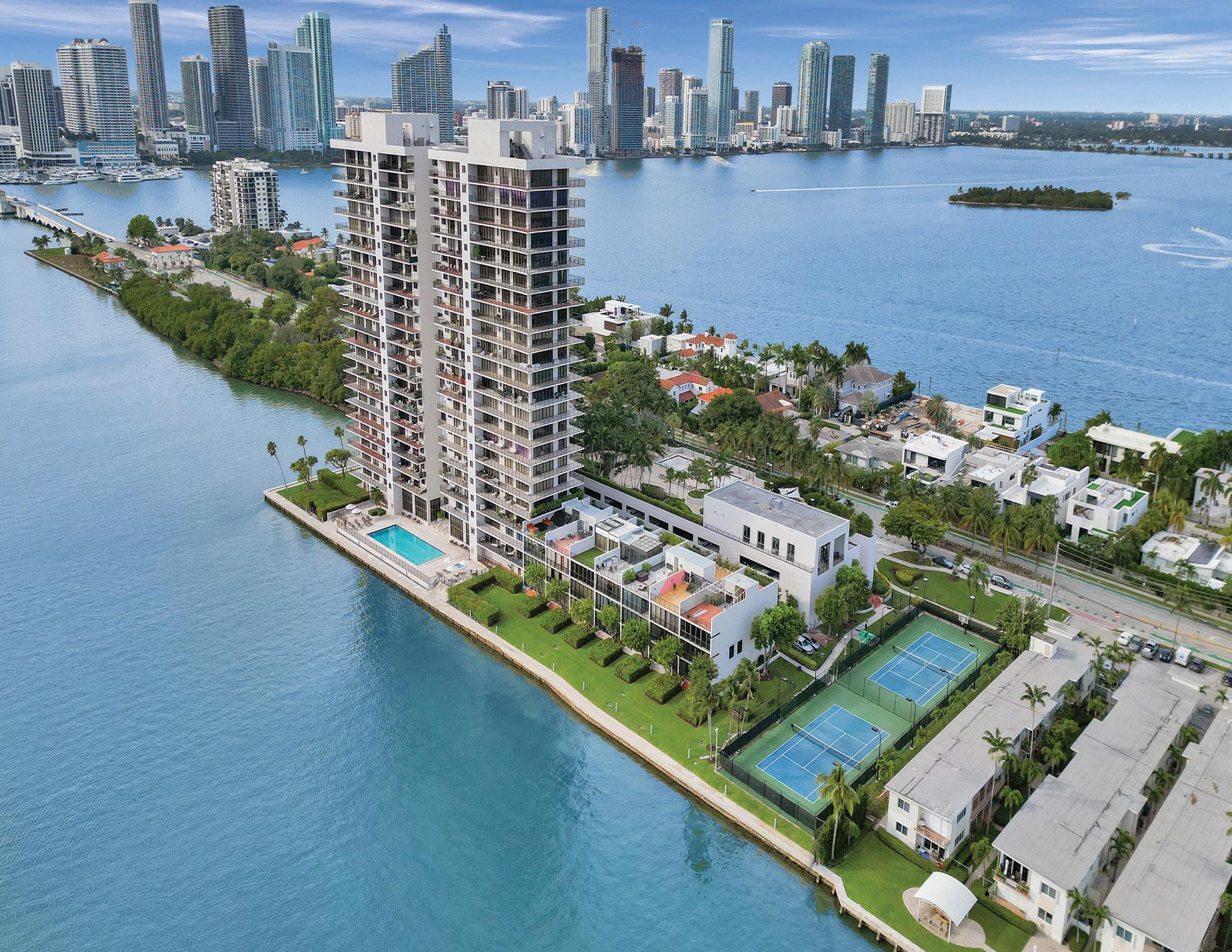
With many home sellers locked into low interest rates, luxury markets across the U.S. are seeing low inventory. From Miami to Santa Barbara, luxury buyers are eager to purchase a limited supply of homes.
Though it might seem like that would easily give sellers the upper hand, agents’ feelings are mixed. In a survey
of Berkshire Hathaway HomeServices network agents, respondents were nearly evenly split between describing their markets as buyer’s markets, seller’s markets or balanced.
What agents do mostly agree on, is that the strength of the market varies across different price points,
as do the demands of the buyer.
“There’s no shortage of buyers in the luxury realm,” said Martha Mosier, president of Berkshire Hathaway HomeServices California Properties in Southern California. “But we are seeing consumers paying attention to different things across different price levels.”
Over the next year, supply is expected to increase—already from May 2023 to May 2024, inventory for luxury homes increased 31%, according to the Institute for Luxury Home Marketing, and according to our survey, nearly 52% of agents say inventory for entry- to mid-level luxury has increased over the past year; for super-luxury about 52% say it stayed the same. (See page 5 for a breakdown of the segments.)
As inventory comes onto the market, sellers will have to work even harder to stand out from the crowd—a concept difficult for some after years of a frenzied post-Covid market.
“We had lines of people out the door for open houses,” said Ron Shuffield, CEO and president of Berkshire Hathaway HomeServices EWM Realty in Miami. “We aren’t having days like that again— but we still are seeing a very steady demand for properties.”
When it comes to concessions, more than half of agents surveyed said that they are seeing sellers more willing to offer concessions than in the past few years, which can come in the form of reduced prices, credits or high-end inclusions, agents say. Interest-rate buydowns have also become popular among buyers of entry-level luxury as a way for sellers to maintain a high price but help a buyer achieve a more affordable monthly mortgage payment.
Luxury agents say that those concessions aren’t always necessary, though, for some of the best-in-class assets in the market. Here’s what agents say home buyers on the market are looking for across different price points.
In recent years, real estate experts have noticed a shift toward properties that require little renovation and are ready for move-in. Nearly 70% of survey respondents said that’s what their buyers want.
“In the past, buyers would be amenable to a house that needed a lot of work, but now they want the proverbial ‘turnkey home,’” Mosier said.
What’s changed? With higher price points come higher expectations.
“You’ve got millennials who are paying $2 million for a home that someone bought decades ago for $80,000,” she said. “For the convenience of moving into a home that’s move-in ready, buyers are willing to pay top dollar.”
Mark Pasquesi, president of Berkshire Hathaway HomeServices Chicago, said he’s also seen some sellers offer credit toward renovations, if they don’t want to take on the renovations themselves.
In resort towns, furnished condos are a popular choice for entry-level luxury buyers, said Steve Roney, CEO and owner of Berkshire Hathaway HomeServices Utah Properties in Park City. Buying a property that’s entirely ready to go may make it easier to rent on Airbnb or other sites.
"As you go through the luxury spectrum, at the beginning, people are more looking for rental income,” said Roney. That rental income may even be necessary to help them pay their monthly mortgage.
Meanwhile, at the upper end of the spectrum, buyers are more likely to hire interior designers and customize their
31%
From May 2023 to May 2024, inventory for luxury homes increased 31%, according to the Institute for Luxury Home Marketing.
52%
A survey of Berkshire Hathaway HomeServices network agents found that nearly 52% say inventory for entry- to mid-level luxury homes has increased over the past year, while nearly 52% say it's stayed the same on the super-luxury level.
A
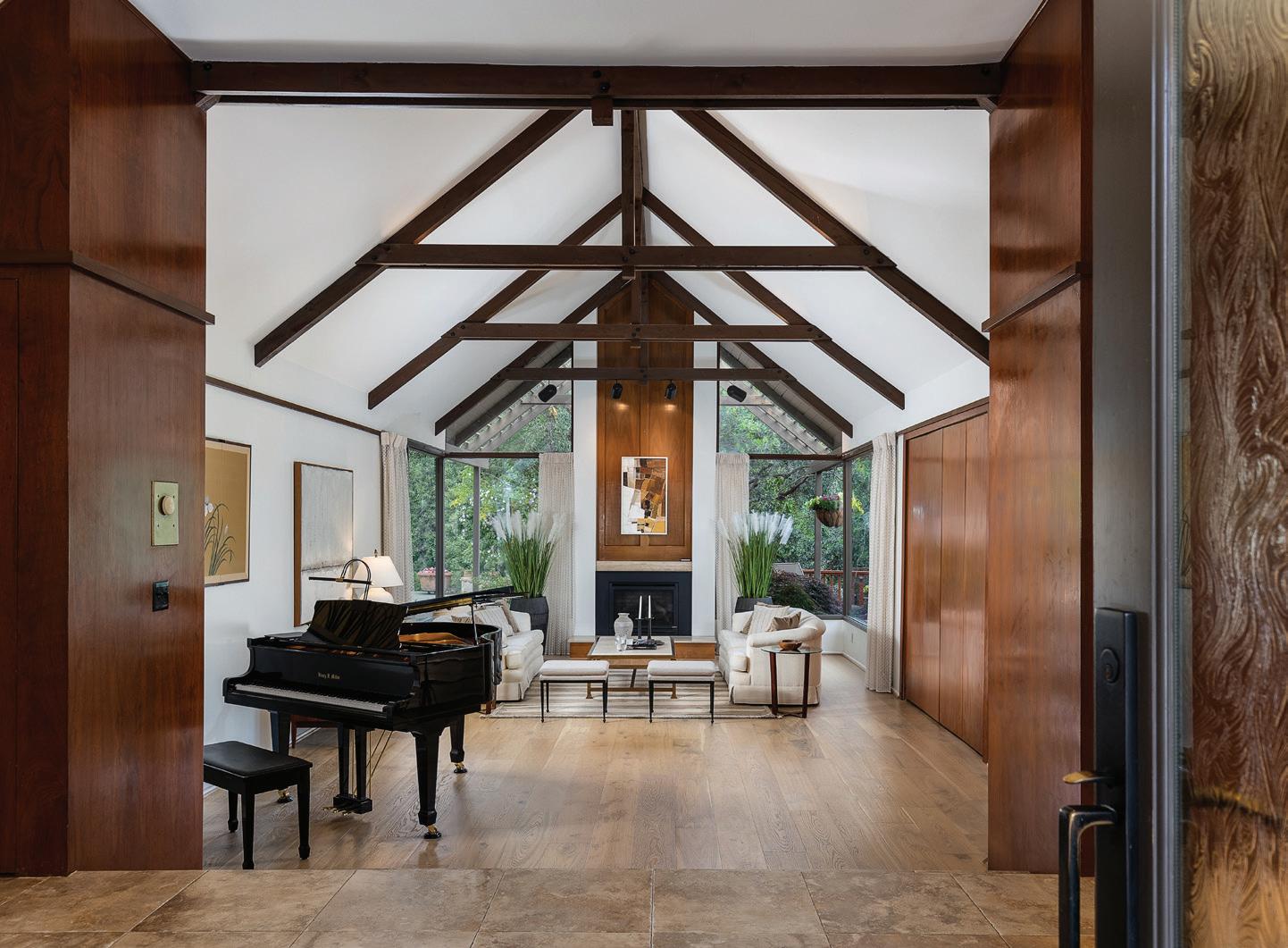
space, rather than rely on furnished apartments. Those are the ones for whom turnkey isn’t as valuable. “The higher up you get in the luxury spectrum, the more people want to do their own furnishings and design,” he said.
These days, there’s one room that buyers care about more than almost any other: the kitchen.
“Kitchens have become the entertainment center for the home,” Shuffield said. “They’re no longer buried in the back for catering staff.”
Home sellers at nearly any price point across the luxury market can give themselves an edge by renovating their kitchen with modern appliances and finishes, or knocking down walls that isolate the space from the rest of the house.
Likewise, sellers—especially on the upper-end of the luxury market—can also give a boost to their listing by offering an extensive outdoor area for entertaining.
“They’re no longer using their out-
door space just during peak seasons— they want to be outside all year long,” Shuffield said.
Luxury buyers are increasingly prioritizing locations that align with their lifestyle—whether that be skiing in the mountains, lounging at the beach, or enjoying hikes and biking along the California coast.
While entry-level to mid-level luxury buyers may be content to be within a short drive from their favorite beaches or hikes, those on the upper-end often are willing to pay a premium for choice locations. In Park City, with over 300 inches of snowfall each year, higher-end buyers will pay top dollar for a “ski-in, ski-out property,” Roney said. Likewise, he’s seen an increased interest in resorts centered on a golf course, or with access to mountain bike trails.
In Lake Geneva, Wisconsin, a resort area north of Chicago, Pasquesi has also seen sellers offer a membership to
a boat club with the home purchase.
Beyond proximity, luxury buyers are also looking for extensive amenities packages in their condo or resort. In Miami in particular, with its strong condo market, buyers in new luxury towers are looking for impressive amenities— high-end gyms, in-building spas, virtual golf, car elevators.
“Anything you can dream of putting in a house, we’ve already done it,” Shuffield said.
The trend among buyers to make vacation destinations their permanent and semipermanent residences continues.
Even in Miami, which traditionally has seen strong foreign demand, the number of domestic sales has been on the rise.
“Most of our wealthier buyers were coming from outside the country—but now, the share is not as high as it was before Covid,” Shuffield said.
As a result, their needs are different— buyers moving with their families are looking for neighborhoods near good
schools and public parks, while older buyers are taking note of proximity to top hospitals.
In California, buyers are also weighing whether to buy homes near fire zones as insurance gets more and more expensive—and in some cases, entirely unavailable. That may make it more difficult for buyers to get a mortgage, which affects the entry- to mid-level luxury the most.
“Even in the luxury market, we’ve had situations where insurance is almost cost-prohibitive,” Mosier said.
Even with limited inventory and increased competition, luxury buyers at all levels have shown they are rarely willing to settle. Sellers who can position their home as a “best-in-class” asset are more likely to get the best price, experts said.
“When the inventory gets higher and the months of supply increase, prices begin to level off because the buyer has more to choose from,” Shuffield said. “Sellers need to do what they can to stay competitive.”•
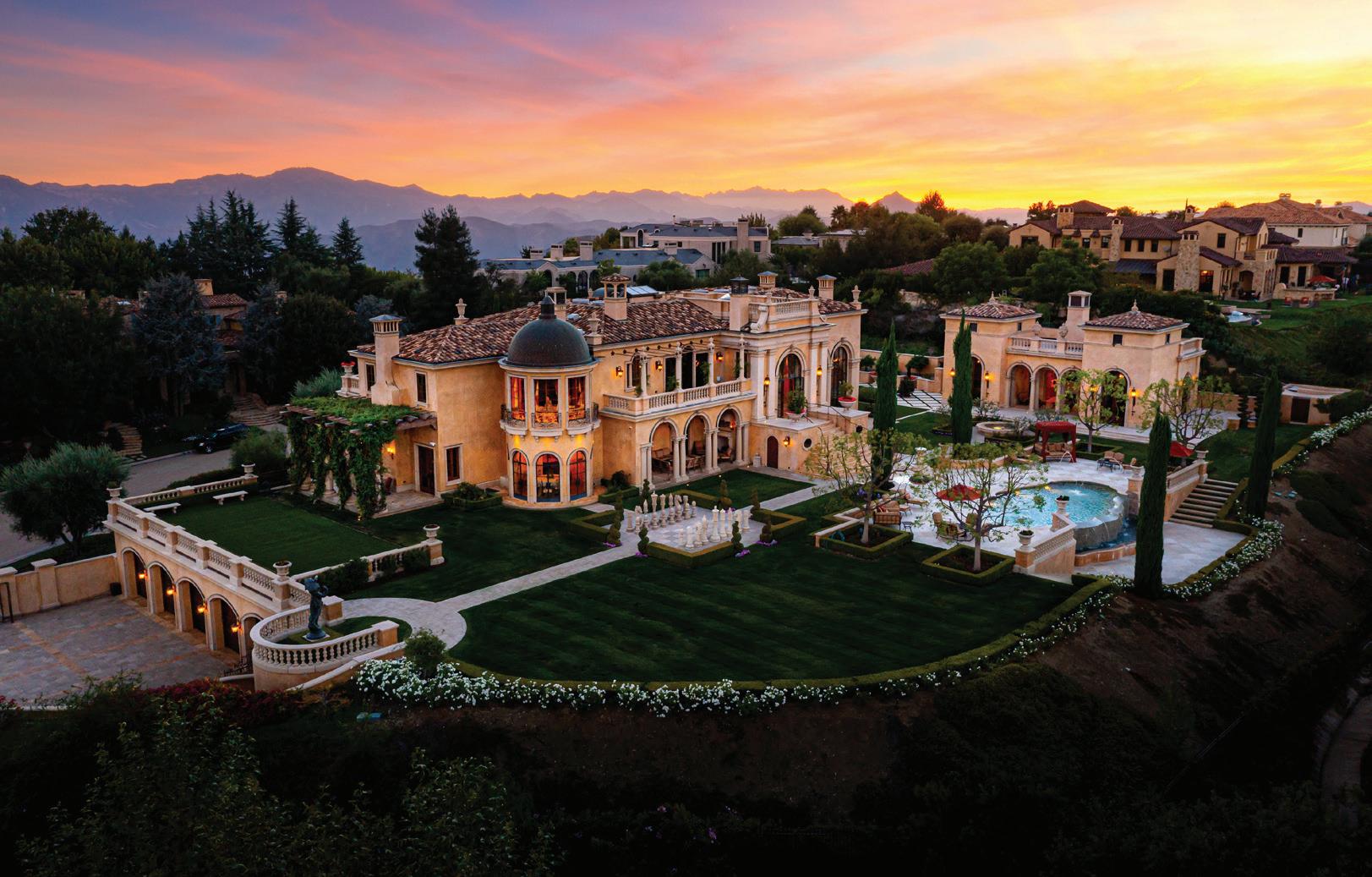
Luxury Price Points
We surveyed Berkshire Hathaway HomeServices network members to get a sense of how they define the different layers of luxury in their areas. Below are the breakdowns.
ENTRY-LEVEL LUXURY
$455,000*to $5 million**
MID-LEVEL LUXURY
$675,000*to $10 million**
SUPER-LEVEL LUXURY
$1 million*** to $30-plus million****
Source: Berkshire Hathaway HomeServices 2024 Global Luxury Landscape Market Report Survey. Ranges provided by: *Berkshire Hathaway HomeServices Ally Real Estate in Northwest Louisiana; **Berkshire Hathaway HomeServices Colorado Properties; ***Berkshire Hathaway HomeServices Tomie Raines, REALTORS®; ****Berkshire Hathaway HomeServices California PropertiesOrange County and Berkshire Hathaway HomeServices Nevada Properties
Compared with the frantic pace of 2021, the luxury market in Santa Barbara, California, has slowed a bit but remains strong.
“We are seeing an increase in sales this year compared to 2023,” said Martha Mosier, president of Berkshire Hathaway HomeServices California Properties.
Through July 2024 Santa Barbara saw 338 sales, compared with 296 for the same period of 2023, she said. “That’s a pretty significant increase.”
It’s still a slow year compared with that “unicorn year of 2021,” she said. “We’re increasing sales, but in a threeyear look-back, we’re still down.”
Prices have also risen steadily, “again, nothing like 2021, when we were seeing double-digit increases,” Mosier said. The current median sales price in Santa Barbara, which includes the “uber-luxury” Montecito market, is $2.252 million, compared with $2.1 million last year.
Prices Climb Amid Small Inventory Wins
Pending sales are also up compared with 2023, she said, and inventory has also gotten better. Year to date, Santa Barbara has 550 active listings, compared with 440 last year.
“Inventory is up and prices are still climbing,” she said. “You’re not getting in for under $2 million in Santa Barbara.” In Montecito, the average sales price is $5 million.
“We have a vast array of types of housing in our market, including a lot of equestrian properties,” Mosier

said. “I’m seeing a trend toward more move-in-ready types of homes.”
As far as higher interest rates, “our market is kind of impervious to that because predominantly we have cash buyers,” she said. “More than 50% of our luxury buyers are paying cash.”
Rising insurance rates, across the state, are more of a concern, she said.
As far as where luxury buyers are coming from, “we have a lot of out-of-area buyers,” Mosier said. Many are buying a second or third home.
“We have a lot of people coming from Los Angeles and San Diego and Orange County who are moving up to Santa Barbara, also a lot of out-of-country and out-of-state luxury buyers,” she said.
“We have a slower pace than L.A.—it’s more tranquil here—and that’s what luxury buyers are looking for, and privacy is very significant for a lot of residents who pick this area,” she said.
“We have a beautiful secluded high-end market,” Mosier said. “We have mountains, we have vineyards and we have ocean, along with some of the best weather in California— similar to a Mediterranean climate.”
Santa Barbara is “like a quaint village that offers culture and exceptional cuisine,” she added. “It’s an enclave that’s really unique and a special place where culture and sophistication meet. It’s a fairy-tale land.”
Yet you can be in Los Angeles in no time, she said. “Within two hours you can be in downtown L.A.”
Looking ahead to the rest of 2024 and into next year, the “trend is steady,” Mosier said. Sales prices are “holding their own, slightly increasing, and inventory is opening up a little.”
“A lot of significant luxury houses used to sit on the market for a very long time,” and that’s no longer the case, she said.•

A perfect storm of increased demand for luxury properties due to the global pandemic, coupled with historically low interest rates, a booming stock market and a strong U.S. economy led to a real estate frenzy that sent prices skyrocketing across most of the U.S. in 2021 and the first half of 2022, with many resort and tertiary markets experiencing double-digit price growth. The past two years have seen falling transaction rates in many markets both in the U.S. and internationally as interest rates were gradually hiked in an attempt to curb inflation. But a long-running shortage of inventory, particularly in the U.S. luxury market, has seen prices continue to rise, if somewhat more slowly than the recent years past. A “unicorn year” like 2021 is
unlikely to come around again anytime soon, but as mortgage rates begin to fall, steady growth in both demand and prices is likely to mark the years leading up to the next big housing peak.
During the last peak, the stock market was at an all-time high and interest rates were at historic lows, said Rei Mesa, president and CEO of Berkshire Hathaway HomeServices Florida Realty. “All those tail winds have changed now; they’ve actually become headwinds.”
“Home sales were the same in 2023 as they were in 1995, but there are 70 million more people living in the country,” said Lawrence Yun, chief economist and senior vice president of research at the National Association of Realtors. “To the degree that many view
owning as part of their American Dream, we should expect more home sales in the future. Better market conditions of lower interest rates and more inventory will help greatly.” He added that some housing booms can be sudden and of short duration, while others are steadier and of longer duration. “We had a quick sequence of boom-andbust sales in 2020-21 and 2022-23,” he said. “The next 10 years look to have a mostly steady gain, and the majority of those years will have positive gains.”
Lower mortgage rates, higher household incomes and greater housing supply are all critical factors in paving the way for another market peak, said Mark Zandi, chief economist of Moody’s Analytics. He predicts a long, slow return to
The Election Effect
We asked network members whether they expect the U.S. election to impact the real estate market.
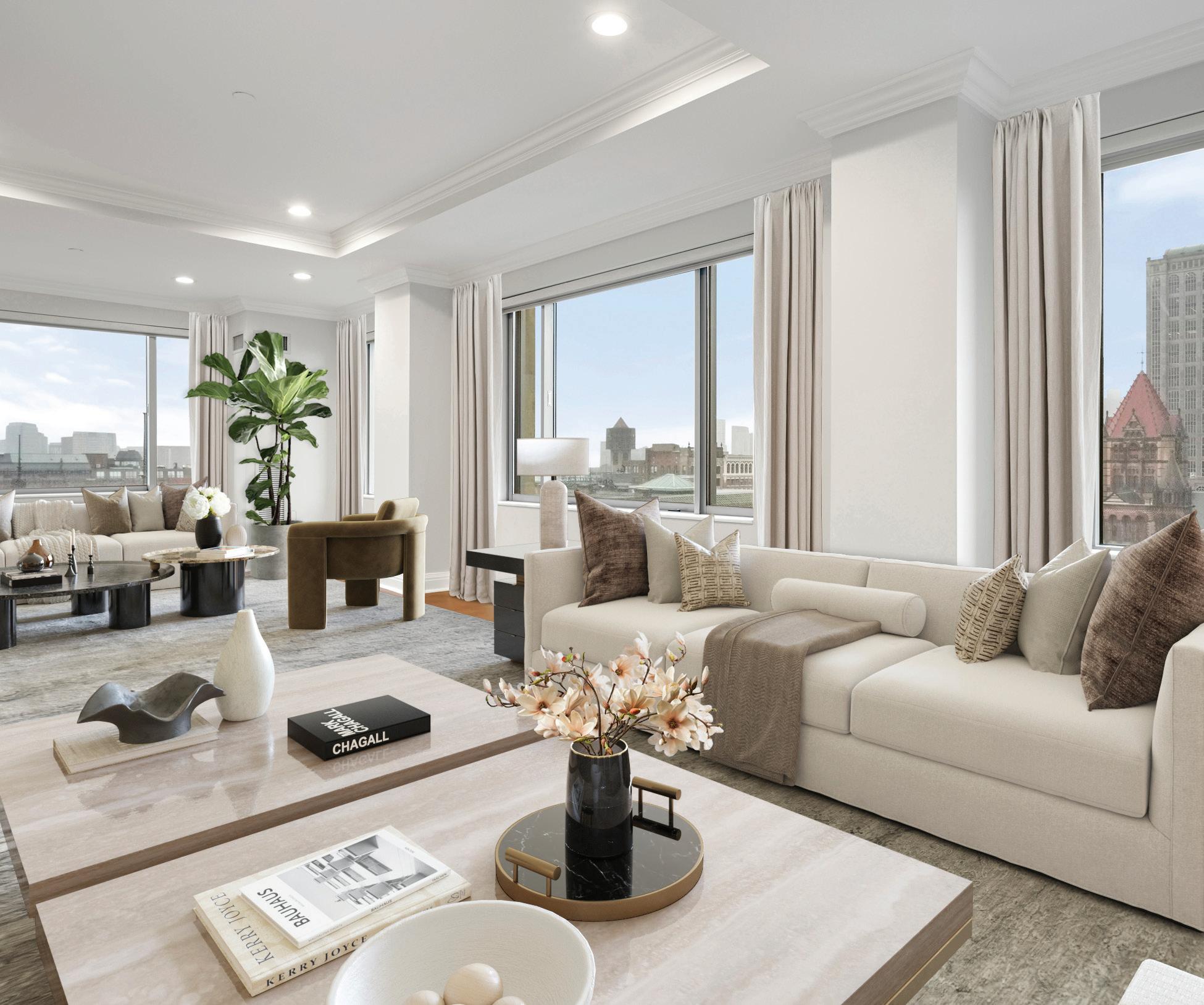
Macro Effects Network members pinpointed which factors affect
estate decisions most.
Source:
a more balanced market, a process that has already begun as interest rates have fallen slightly in 2024. “Mortgage rates should drift lower over the next couple of years and settle just under 6%,” he said. “With a likely soft landing for the economy, household incomes should continue to advance. Increasing housing supply will be more difficult for a host of reasons, but it should steadily improve in coming years, especially if lawmakers provide financial support.”
Slow, stable growth is no bad thing. The double-digit price growth and bidding wars that characterized many markets in 2021 and early 2022 were unsustainable, said Mike Aubrey, executive vice president and principal at Mike Aubrey Group of Berkshire Hathaway HomeServices PenFed Realty. “That kind of thing can only go on for so long before you begin to price everyone out of the market, whether it’s in the low end or the luxury space,” he said. “When you have a trajectory that moves that high and that fast, it creates instability. Specifically in the luxury space, the market is
“Home sales were the same in 2023 as they were in 1995, but there are 70 million more people living in the country...to the degree that many view owning as part of their American Dream, we should expect more home sales in the future.”
Lawrence Yun Chief Economist, Senior Vice President of Research National Association of Realtors
normalizing, and I think that ’s healthy.”
Despite a slowdown in the number of home sales over the past two years, prices have remained consistently high in the luxury sector, continuing to rise year over year from the levels set during the pandemic. In April 2024, following 10 straight months of annual appreciation, the CoreLogic S&P Case-Shiller Index suggested that home prices were continuing to hit new highs and were up 4% overall, compared with the June 2022 peak. Annual appreciation remained above 5% in the overall U.S. housing market, although it is predicted to slow to 3.4% by April 2025.
Shortage of inventory remains one of the primary reasons for sustained high prices. This is a long-term issue that dates back to the 2008 recession, when many builders went out of business and most of those who survived stopped building on spec, leading to a shortage of new homes, Aubrey said. “We really should have been building about 1.9 million units a year in the U.S. since about 2010, and for the longest time what we were building was more like 1.1 million to 1.2 million units,” he added.
This continuing shortage was exacerbated by the pandemic boom, particularly in resort and tertiary markets where luxury properties were subject to intense bidding wars. “During the second half of 2021, the inventory of luxury homes reached an all-time low,” said Larry Flick V, CEO of Berkshire Hathaway HomeServices Fox & Roach, REALTORS®. “In fact, from 2019 to 2022, over that three-to four-year period, the inventory of luxury homes decreased by 55% in the mid-Atlantic’s three major metro areas”—Baltimore, Philadelphia and Washington, D.C.
While luxury property is generally less impacted by rises in interest rates than other sectors, due to the preponderance of cash buyers, the shortage of inventory has been further compounded
because higher mortgage rates over the past two years have created a lock-in effect. Homeowners are reluctant to trade in a low-interest mortgage for one several percentage points higher, preventing some sellers who might otherwise have chosen to move from putting their homes on the market. But this is set to change in the coming year or two. “Mortgage rates are likely to descend a bit, and that will loosen the strength of the ‘golden handcuff,’” Yun said. “The lower the rate, the more that pent-up delayed listings will come onto the market. I believe the market will look more balanced by the middle of next year.”
The tipping point has already been reached, said Flick, as mortgage rates have fallen from 7% into the 6% range. Activity will accelerate as they decrease further. “Inventory is improving but very slowly,” he said. “In most markets across the country average sales price continues to increase, but the rate at which average sales price has been increasing is slowing in pretty much every market… Inflation seems to have peaked and interest rates are probably going to come down over the next year or two. It’s hard to say what impact that’s going to have on the average sale price.”
Given the historic shortage of inventory, more homes entering the market is unlikely to bring home prices down. “Home prices have been setting new highs consistently. From this point forward, both prices and sales will encounter modest yet steady gains,” Yun said. Demand for luxury homes remains high globally and the outlook for the coming five to 10 years is positive, particularly in many of the U.S. resort markets that saw huge surges in demand in 2021. “More remote work will help ditch big cities and people will seek out fun, resort destinations,” he said. “High wealth, as currently in the stock market, will also help.”•
During the second half of 2021, the inventory of luxury homes reached an all-time low...in fact, from 2019 to 2022, over that three-to four-year period, the inventory of luxury homes decreased by 55% in the mid-Atlantic’s three major metro areas.”
Larry
CEO
Flick V
Berkshire Hathaway HomeServices Fox & Roach, REALTORS®
According to a recent CoreLogic S&P Case-Shiller Index, annual home price appreciation remains above 5% in the overall market, though it's expected to slow to around 3.5% by April 2025. 5%
How quickly transaction rates are expected to pick up varies across different areas of the U.S. and internationally. Below, we looked at a few top markets around the world.
Prices peaked in 2021 and “we hit the bottom in the fourth quarter of 2023,” said Larry Flick V, CEO at Berkshire Hathaway HomeServices Fox & Roach, REALTORS®, whose area covers Eastern Pennsylvania, New Jersey and Northern Delaware. “We pretty much had a twoyear correction, where we had a decrease in unit sales in the range of 15% to 20% per year. As interest rates continue to move down slowly, I think home sales are going to continue to increase over the next five years or so.”
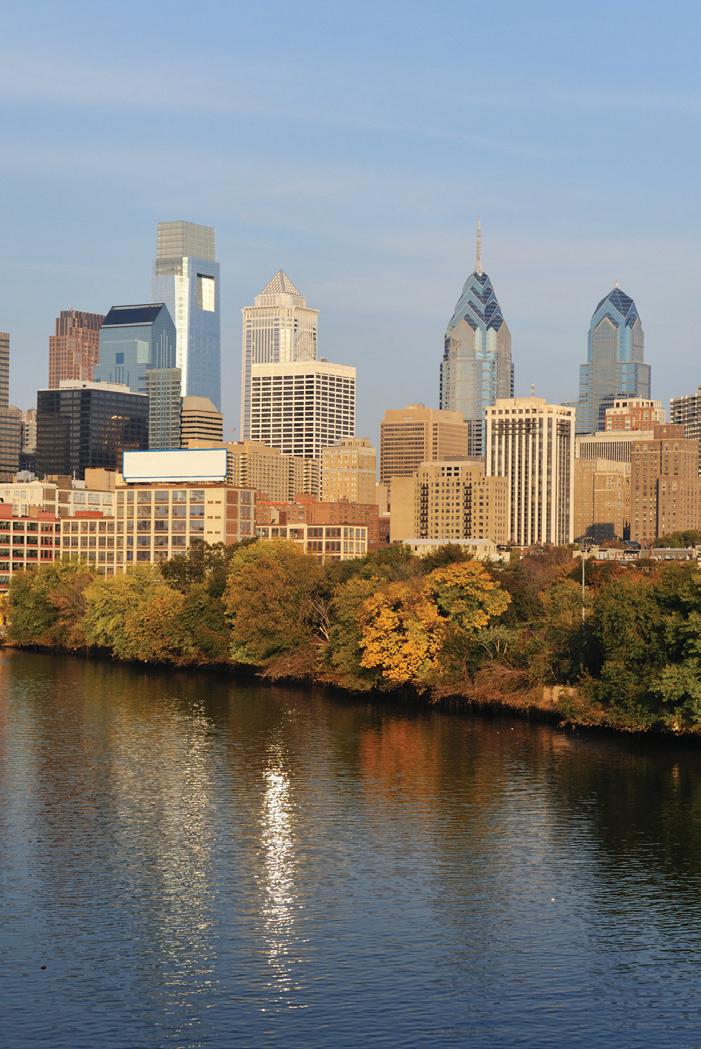

After a drop in sales volumes following the 2021 peak, the winds are set to shift. “Historically, second-home buyers, luxury buyers and trophy-home buyers tend to sit on the sidelines when there's a presidential election,” said Rei Mesa, president and CEO of Berkshire Hathaway HomeServices Florida Realty. “So I do see a much better opportunity in 2025 and 2026.” He expects transaction rates to return to 2019 levels in the coming year, coupled with the higher prices that are a legacy of the last market peak. “Prices in 2021 and 2022 went up and we're just not seeing those prices coming down,” he added.•

Italy also experienced a strong peak in 2021, and it 's expected to heat up following a period of slower growth. “Some of the factors we'd need to meet to reach a similar peak in the future are economic stability in Italy, foreign investment appeal, supply consistency and demand for quality living spaces,” said Marina Rizzotto Yakovleva, founder and CEO of Berkshire Hathaway HomeServices Palazzo Estate, adding that it usually takes three to five years to reach another peak after the market has experienced a boom.
“Now we have a special situation because of the 2026 Winter Olympics in Italy,” she added.
“We are expecting increased demand in 2025…In Milan, we already have a lot of demand and a lot of inventory. Maybe we're not yet at the brink of another peak but the conditions are setting the foundations for potential future growth.”
Despite transaction rates dropping by 25% to 30% since the pandemic, “prices have still gone up in pretty much every town and every neighborhood in and around Eastern Massachusetts, including Boston,” said Nick Warren, founder and CEO of Berkshire Hathaway HomeServices Warren Residential. Boston's high average home prices mean that the market is particularly susceptible to interest-rate fluctuations. “Our average condo sale price in Boston is well over $1 million, so I would say the $5 million and less market is definitely affected by interest rates,” he said. “The whole point of real estate is that you can leverage it, so even the higher-net-worth people typically put a mortgage on a property, even if they bought it in cash originally. So it is affecting just about everybody across the board.”
Despite this, low inventory is pushing prices higher, particularly in the suburbs, where demand skyrocketed during the pandemic. For properties priced between $750,000 and $1.5 million, “you’re seeing multiple offers still, people waiving contingencies, that type of thing,” he said. Going forward, he expects to see transaction volumes increasing incrementally, coupled with steady price growth. “I think we'll see what historically is more of an average, that 3% to 5% appreciation range [annually],” he said.•
Washington, D.C.
The luxury market is “the portion of the space that is least impacted by underlying issues in the economy,” said Mike Aubrey, executive vice president and principal at Mike Aubrey Group of Berkshire Hathaway HomeServices PenFed Realty. “We’ve not seen significant movement in the space since 2021, other than the fact that we’re seeing fewer offers on houses. In 2021, you could put a house on for $5 million or $6 million and expect to get multiple offers and the price still go up. At this point, that house is still selling, but it’s not necessarily getting five or six offers on it to drive the price.” A return to such a strong seller's market is unlikely unless interest rates were to suddenly fall by two or three percentage points, he said. “It would have to be something dramatic along those lines to see a peak demand like we saw during Covid. We're not talking about feast or famine discussion here, though. The market is still really good.”
Unlike the Boston market, the luxury market in Washington, D.C., is minimally affected by interest rates, he added. “We’re probably somewhere around 75% cash buyers for any purchases that are over $3.5 million, so I think it takes the discussion of mortgage rates out of the equation,” he said. Buyers in the luxury space are spending more because “real estate is a pretty good hedge against inflation,” he said. Overall, he said, there are “multiple shots in the arm” benefiting the luxury space.•
The market in the Greater Seattle, Washington, and Portland, Oregon, metro areas “continues to lean toward sellers,” said Melanie Weidenbach, president and CEO of Berkshire Hathaway HomeServices Northwest Real Estate. But the pace and fury is less intense than during the pandemic-driven boom, which Weidenbach described as a “unicorn.” Still, relatively limited inventory is expected to lead to slightly increased prices “at a more modest level than the spikes seen during the ‘boom,'” she said. Overall, the luxury market has had a good 2024, Weidenbach said, “with some luxury buyers who are less influenced by interest rates taking advantage of increased inventory.” Both metro areas she covers offer appealing lifestyles, she said, with proximity to water, mountains and a balance of urban living with outdoor activities. “Location and how well-prepared the homes are for the market—especially in the luxury segment—are important factors in driving demand in the present market.”•

On this island, known for its 80 miles of beaches and historic grayshingled homes, the living is easy.
Located 30 miles off the coast of Cape Cod, all 30,000 acres of Nantucket are considered a historic district.
Adding to the allure: There are no traffic lights, no chain stores and the homes must adhere to strict building regulations, translating to a quaint and charming atmosphere.
In Monomoy, a quiet waterfront neighborhood two miles from town with views of the harbor, one home sold for a record $42 million last year.
“In Monomoy, you have the beach, the guesthouse, pool and tennis court,” said Robert Sarkisian, owner of Berkshire Hathaway HomeServices Island Properties Nantucket. “And if you’re a boater, the bonus is there’s docking.”
The Cliff neighborhood, known for its conservation trails, beachfront
restaurants and luxurious homes, offers exceptional waterfront views. “This is the most exclusive area because it’s located at a high elevation and isn’t susceptible to water damage,” Sarkisian said.
On Easton Street, anchored by the historic Brant Point lighthouse and beach, where old money once reigned, new buyers “will pay $15 million to knock down a home and start over,” he said. “This is a prime area because you have the view of the harbor, you can walk to the beach or town and you have a dock.”
The allure of this New England island has always been its sophistication, which manifests in award-winning restaurants, a robust theater scene, museums (the Whaling Museum is a must-see) and cultural offerings. The downtown is replete with cobblestone streets, church spires and luxurious boutiques.
“Our downtown has been named one of the top 10 prettiest in America,” said Sarkisian. “There’s a feeling like you’re stepping back in time.”
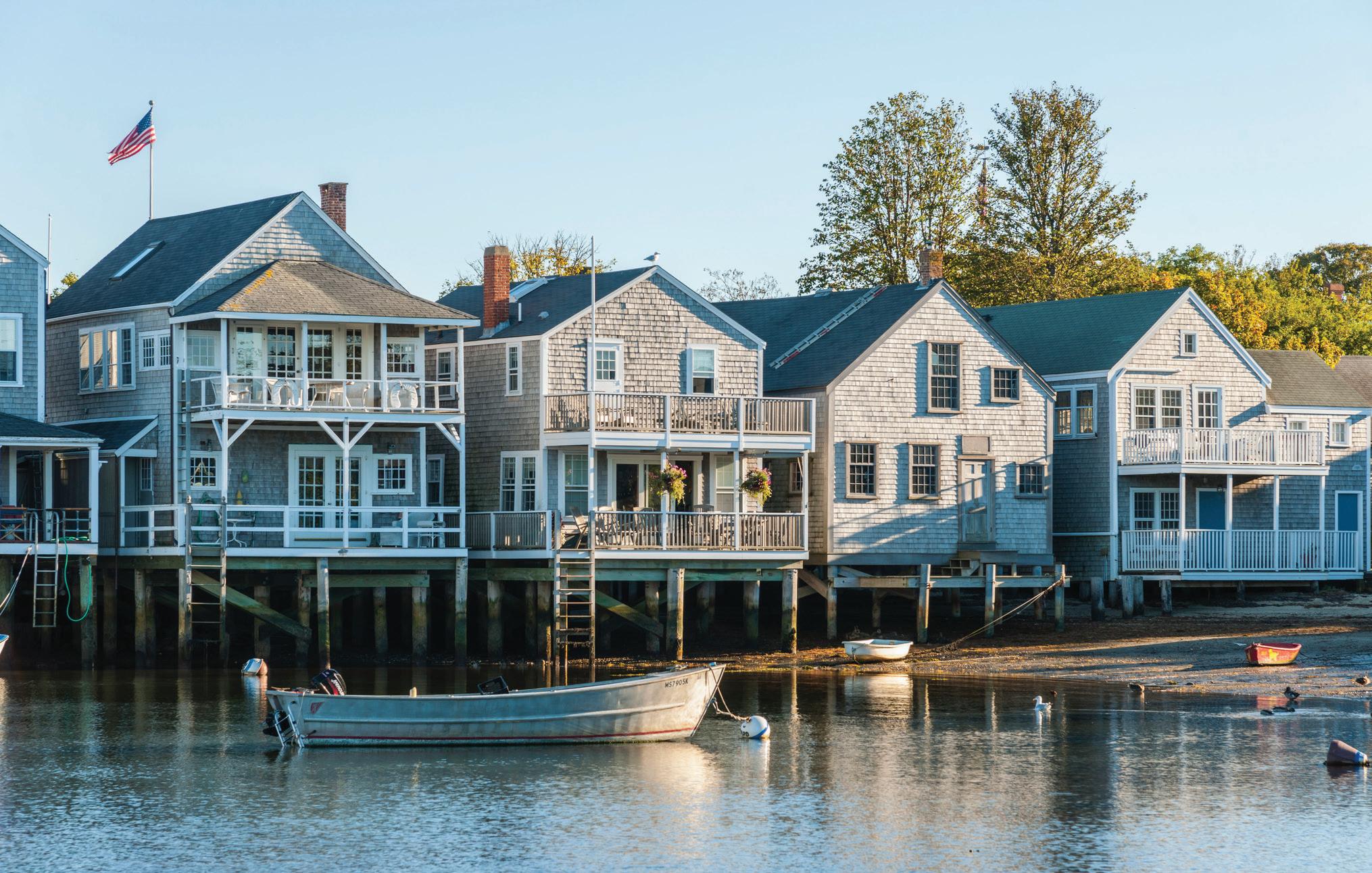
Bike paths connect the entire island; there are endless opportunities to fish or sail; and there is every type of club here to suit your sport, from the Nantucket Golf Club to the Great Harbor Yacht Club and Westmoor Tennis Club.
Two ferry lines service the island and the use of private jets has made Nantucket’s airport the second busiest in New England after Boston’s Logan Airport. The island’s proximity to New York City and Boston makes it an appealing place for second-home owners.
Best of all, more than half of the island has been deemed conservation land.
“That has kept prices high,” Sarkisian said. “There’s not as much land to build on, but it also makes for less congestion.”
Nantucket’s real estate market remains highly competitive (the average sale price is $6.67 million), but inventory remains low. In the third quarter of 2024, there were 230 available listings; a healthy market would have over 500 available listings, Sarkisian said.
“Our inventory levels are up 60%, but we still have a long way to go,” he said. “My hope is now that inventory is up 60% from last year, we’ll start to see some price softening.” More listings are seeing price reductions, he said, “and that’s a healthy sign.”
The state of the financial markets is often the biggest predictor.
“Bankers are getting bonuses again,” Sarkisian said. “That money will land here—we’ve always been a safe place to park money.”•
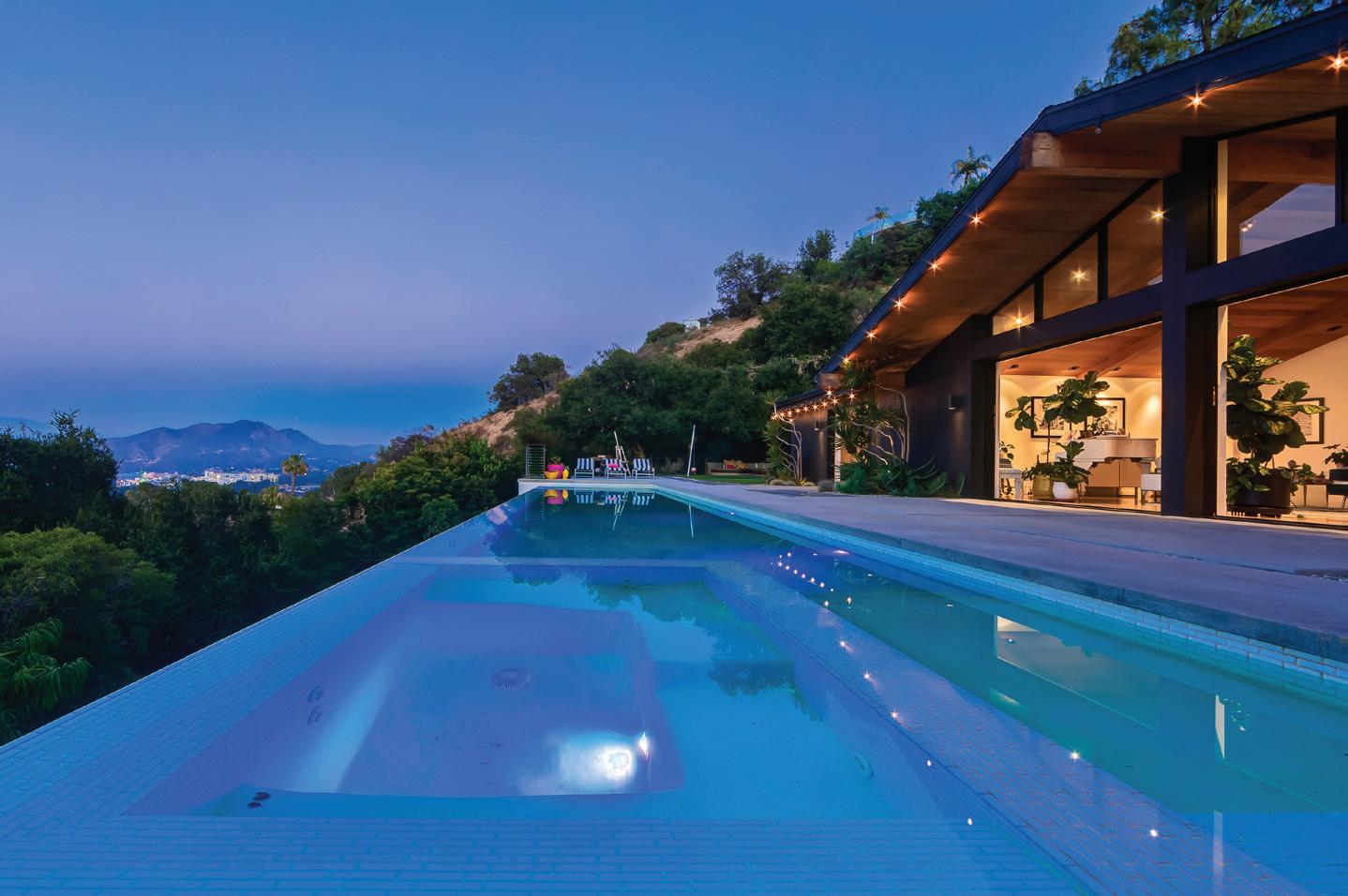
Despite headwinds of inflation, high mortgage rates and geopolitical uncertainty, wealthy home buyers continue to invest in luxury playgrounds from Hawai’i to Hilton Head, Aruba to Aspen and The Bahamas to Baja California, Mexico. Most investors use their properties part of the year and hold onto them for generational wealth building, with some opting to rent them occasionally for income, which can be significant in some popular areas. However, before counting on shortterm rental opportunities, investors must be aware that jurisdictions and some homeowner associations increasingly impose restrictions on owners that may limit their ability to rent their property.
Demand for luxury investment properties remains strong, according to nearly 56% of Berkshire Hathaway HomeServices network agents surveyed.
Home prices rose 15% in The Bahamas, compared with 3.1% globally in 2023, according to Jim Bernard, president, broker and appraiser with Berkshire Hathaway HomeServices Bahamas Real Estate in Lyford Cay, The Bahamas.
“Our market has been strong and seems to be getting stronger,” Bernard said. “We’re tax friendly, have great weather and more direct flights than most other Caribbean islands.”
Tourism in The Bahamas was up 38% in 2023, compared with 2022, Bernard said. Tourists arriving by air increased another 3.5% from January to April 2024, compared with those months in 2023, and those arriving by cruise ship increased 15%, according to The Bahamas Ministry of Tourism and Aviation. Most luxury
buyers come from the East Coast of the U.S., Canada and London.
The high-end market starts at $5 million to $6 million, Bernard said, with a growing number of luxury buyers buying on more remote islands and some buying oceanfront teardowns to build custom homes.
“Most of the high-end investors use their homes a few months each year and don’t tend to rent them out,” Bernard said. “Buyers in the $1.5 million-andunder price range are most likely to rent their homes to vacationers.”
The Bahamian government implemented a 10% value-added tax on short-term rentals in 2023. Some homeowner associations restrict short-term rentals, while others encourage them, Bernard said.
“Allowing short-term rentals can help sales because once people experience a property they want to buy there,” Bernard said.
Berkshire Hathaway HomeServices network agents were asked if investment properties are still popular with buyers.
Cabo is no longer a vacation market, it’s more of a second primary home market... Owners who used to spend a few weeks to two months a year are now spending six months or longer. Some of them even enroll their kids in schools here.”
Ian Gengos Owner and Designated Broker Berkshire Hathaway HomeServices Baja Real Estate
Aspen, Colorado, a millionaire haven for decades, is now home to billionaires, said Brenda Wild, broker and owner of Berkshire Hathaway HomeServices Signature Properties in Aspen.
“We’ve seen some recent sales at $77 million and $108 million, which is more than $4,000 per square foot,” Wild said. “Condos that were $1 million before Covid sell for $2 million to $3 million today, and single-family homes that were $5 million now sell for $14 million.”
Restrictive building codes and limited land due to the mountains that surround Aspen mean new homes are scarce.
“Inventory is so low that this is the toughest market in 20 years,” Wild said. “People hold onto their property here for 10 years or longer. You can’t build anything either, especially not a large home.”
For investors who want to use their properties as short-term rentals, it’s possible to get a permit in the village core, Wild said. Outside that area it’s more difficult to get approval.
Property taxes are extremely high in Aspen, but Wild said demand for luxury properties—both sales and rentals—is still robust.
“The big city culture in this small town, the beauty, the character and the outdoor lifestyle continue to bring in people from every generation,” Wild said.
“Cabo is no longer a vacation market, it’s more of a second primary home market,” Gengos said. “Owners who used to spend a few weeks to two months a year are now spending six months or longer. Some of them even enroll their kids in schools here.”
About 85% of buyers in Cabo come from the U.S., Canada and Mexico, Gengos said, although global investors are increasing because of airport improvements.
Uncertainty because of elections in Mexico and the U.S. along with global economic issues contributed to a 30% drop in condo sales over the past year, Gengos said. Many condo owners used their equity to upgrade to a single-family home, and new condos have been built, he said.
“Last year we had a four-month supply of condos and now we have a one-year supply,” Gengos said. “But the ultra-luxury condos at $6 million and up are still sought-after.”
The short-term rental market remains robust in Cabo, with many condo communities providing support for owners who want to rent to vacationers, Gengos said.
$4K PER SQ FT
Aspen, Colorado, has seen some pricey sales as of late, including two homes that sold for about $4,000 per square foot. Condos and single-family homes sell for double or triple what they did before Covid.
Cabo’s luxury home market consists of about 60% condos and 40% singlefamily homes, starting at about $750,000 for a condo and $1.5 million for a singlefamily home, said Ian Gengos, owner and designated broker of Berkshire Hathaway HomeServices Baja Real Estate in San Jose Del Cabo, Mexico.
Luxury buyers fueled rising prices in Hawai’i that lasted until spring 2024, said Kalama Kim, president of Berkshire Hathaway HomeServices Hawai’i Realty in Honolulu.
“During and after the pandemic, affluent buyers realized they could spend more time in their second home and were less influenced by interest rates,” Kim said. “Now, though, we’ve seen a 50% increase in inventory of condos priced at $2 million and up from 81 in June 2022 to 120 in May 2024. There’s a lot of new
supply and sales have slowed a bit.”
In addition, the Lahaina wildfire changed the mind-set throughout Hawai’i to focus on housing for full-time residents, Kim said.
“Now counties have the right to decide how to handle land use including vacation rentals,” Kim said. “More counties are imposing a minimum stay of 90 days or longer for rentals.”
However, Kim said the new rules primarily impact owners of properties in the $1.2 million to $2.5 million range who are more likely to rent them when not in use, while owners of properties priced at $3 million and above are less likely to rent them, he said.
“Our international buyers primarily come from Japan, and with the yen very weak, we’ve not seen a return of Japanese buyers since the pandemic began,” Kim said.
However, prices in Hawai’i have stayed consistent, with the luxury market price per square foot approximately $680 in both June 2022 and June 2024.
Proximity to the ocean drives demand and prices in the luxury market in Hilton Head, South Carolina, said Christina Galbreath-Gonzalez, broker-in-charge of Berkshire Hathaway HomeServices
Hilton Head Bluffton Realty on Hilton Head Island.
“The true luxury market here starts in the $5 million to $6 million range,” Galbreath-Gonzalez said. “Anything under $5 million isn’t going to be oceanfront and would need a swimming pool and to be upgraded to get near that price point.”
Sales in the Hilton Head luxury market peaked in 2022, she said, and dropped to just four sales at $5 million or above
in the first six months of 2024. The rapid increase in luxury prices from 2020 through 2022 appears to have slowed a bit, with values stabilizing but not dropping.
“The biggest factor here is that there’s very little land, especially close to the ocean, that hasn’t been developed,” Galbreath-Gonzalez said. “During the pandemic, buyers started to come in from California, Arizona and Colorado because they could buy oceanfront homes for $3 million or $4 million, which caused a quick spike in prices.”
Demand, which Galbreath-Gonzalez said continues to be strong, primarily comes from East Coast residents.
“Short-term rentals require permits in the town of Hilton Head,” GalbreathGonzalez said, “which keep property values up.”
Like other resort destinations, the luxury home market in Aruba experienced a dramatic price increase during the pandemic, according to Ike Haakmeester, a real estate agent with Berkshire Hathaway HomeServices Aruba Realty in Oranjestad.
“Luxury demand is still strong, but sales are slower and prices are flat this year, especially for single-family homes,” Haakmeester said. “About 60% of our luxury market is condos priced above $800,000, which are still selling quickly. The other 40% is single-family homes for $2 million to more than $5 million, especially if they’re large with an ocean view.”
Most of Aruba’s affluent buyers come from the New York City area and from Canada, he said.
People value homes closer to the beach, nightlife and restaurants, Haakmeester said. “They’re looking for
We asked Berkshire Hathaway HomeServices network members if super-luxury real estate is unaffected by issues that face the general market.
Are super-luxury homes in more of a bubble in your area compared with the general market?
community amenities that are attractive to short-term renters.”
Nonresidents can only use their properties for six months per year, so most owners rent their homes to vacationers. A new vacation rental policy will require owners to register their properties and to ensure that the 12.5% nightly tourist tax is collected, which Haakmeester expects to help upgrade the island’s infrastructure.
“We’re experiencing a revitalization phase on the island, especially with two new high-quality condo and hotel-condos with ocean views starting construction this year,” Haakmeester said.•
Corporate relocations continue to be a big boost for the St. Louis luxury market, which offers more affordability for East and West Coast buyers.
“Our luxury market is currently very, very hot,” said Maryann Vitale Alles, president, CEO and co-owner, Berkshire Hathaway HomeServices Select Properties. “By volume, it’s up 27%, by the number of units sold, it’s up 20%.”
In 2022 to 2023, “we actually had a dip in sales volume, then an increase this year,” she said.
For St. Louis, it once would have been unusual to see any homes priced at $2.5 million or $3.5 million. Not anymore.
Generally, though, in the St. Louis market, luxury is defined as $750,000 and above, Alles said. The current sweet spot is $1.5 million to $2.5 million.
Sellers in the $750,000 to $1 million range are having the toughest time. “They’re probably seeing 30 to 45 days on market,” as opposed to seven to 14 days for higher-priced homes, Alles said.
“We still have a lot of cash buyers and multiple offers,” she added.
Most luxury buyers are corporate relocations, which has been a “really good thing for St. Louis,” she said.
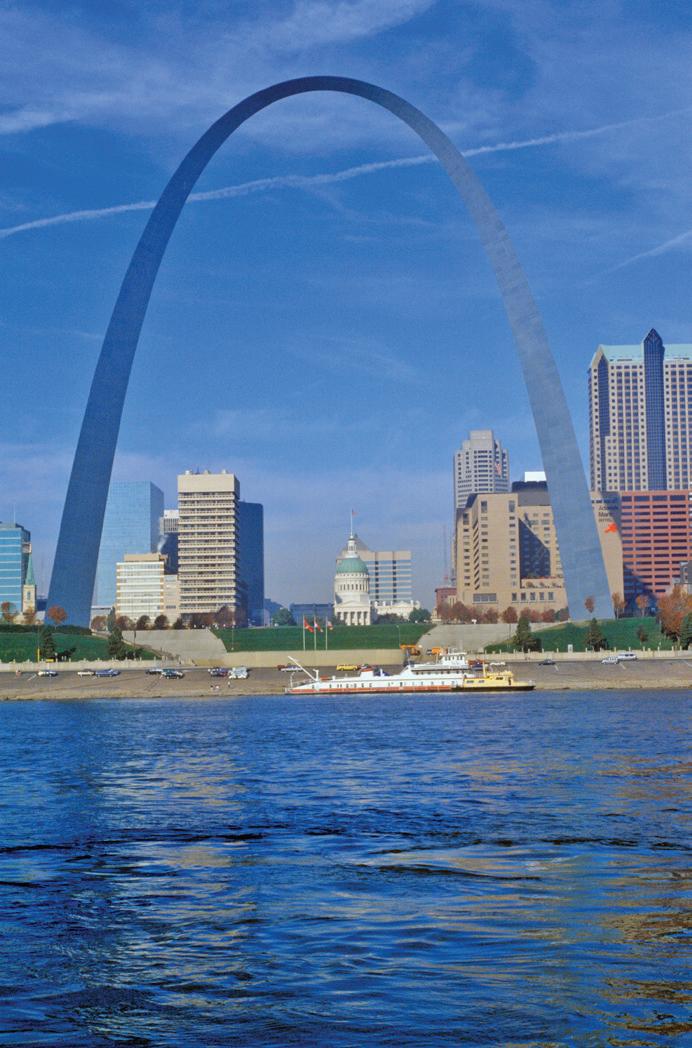
In St. Charles County, which is west of St. Louis, “we never saw milliondollar properties, but in the last four or five years we’ve begun to see that,” Alles said.
It’s still a seller’s market in St. Louis, Alles said. Inventory remains low overall, though the number of units in the luxury market is up.
In especially desirable neighborhoods, such as Kirkwood, Ladue and Clayton, “we’re now seeing a lot of teardowns and infills, with new luxury homes going up on desirable lots,” she said.
For buyers coming from high-priced East and West Coast markets, luxury is a lot more affordable.
These buyers may be paying $400,000
to $500,000 for the lot and then building a house for $1.5 million to $2 million.
“In Ladue and Clayton,” Alles said, “they might be paying $2.5 million to $3.5 million just to build a house.”
As far as the appeal of St. Louis, “we’re a sports town and we have a lot of culture,” Alles said.
“I like to say we’re the best-kept secret,” she said. Also, the weather has mellowed, with milder winters and summers.
Along with brisk single-family home sales, “we’re seeing a lot of apartment buildings going up, all over the place,” Alles said. First-time buyers who may be priced out of the market “have decided to rent and wait.”
The condo market, however, has really taken a hit because of deferred maintenance on capital projects like roof repair and replacement, she said. The condo market is down 60% from last year.
Looking ahead to the rest of the year and into 2025, “I think it will continue to be low inventory and continue to be a seller’s market,” Alles said. “If a seller does everything their agent asks them to do, we will continue to see multiple offers. If interest rates drop, it will get even crazier.”•

Artificial intelligence—AI, familiarly—is becoming a powerful tool across lots of industries, and it’s making waves in real estate, too.
AI adds a new dimension to the home-buying experience, allowing prospective buyers the ability to imagine their dream home, reimagine rooms or even visualize how landscaping or additions might look, thanks to floorplan and design generation. It can also help buyers find a perfect area in which to buy a home by offering detailed insights on certain neighborhoods.
Plus, AI can analyze market trends and demographic data to make predictions about the market, helping sellers, homeowners and investors make smart decisions.
And the future is bright: Like human intelligence, artificial intelligence gets better over time.
With a combination of images, augmented reality, data and 3D models, AI
has the ability to create realistic virtual open houses or tours. Buyers can feel like they’re looking at a property in person even if they’re not.
It also allows prospective buyers to see what a home might look like if it was more modernized or updated—to imagine its potential.
“We’re using AI staging tools to modernize interiors, repurpose a space or reimagine exterior paint jobs,” said Kim Stevens, broker and chief visionary at Berkshire Hathaway HomeServices Pocono Real Estate in Pennsylvania. “You can rethink an entire space and how you want to use it.”
Stevens’ AI toolbox includes staging app VirtualStagingAI.app; HomeDesignsAI, “which allows one to add additions and repurpose a room, for example, from an office to a gym,” she said; and the ColorSnap visualizer from paint company Sherwin-Williams, which enables virtual changes to exterior paint colors.
Staging becomes especially valuable for buyers considering new homes, according to DeAnn Golden, president and CEO of Berkshire Hathaway
HomeServices Georgia Properties in Atlanta, Georgia.
“Virtually painting or staging an empty room really helps buyers visualize themselves in a new home,” she said.
AI also helps inspire and motivate prospective buyers with better descriptions and renderings.
“AI learns how the agent likes to communicate a story, provides a concise description and offers better visual suggestions, whether it’s different lighting,
Berkshire Hathaway HomeServices network members pointed to which technologies are most crucial for home sales.
Which tech is most crucial today for home sales?
Source: Berkshire Hathaway HomeServices 2024 Global Luxury Landscape Market Report Survey.
an alternate photo angle or different paints,” Golden said. “We can reimagine an empty backyard as a landscaped oasis. It helps us give buyers ideas for hopes and dreams of what a home could look like within their budget.”
AI algorithms can help personalize and streamline online property searches because they learn from users’ activity. Online searches become faster and more personalized because preferences such as budget and location are saved.
(Note: AI-powered chatbot, and agent virtual assistants can also engage with potential home buyers during the online search process and provide a jumping off point before connecting with an agent.)
Asking an AI tool about walkability, dining options, or nearby schools can help narrow down neighborhoods or even streets to consider. According to personal-finance site Investopedia, consumers can also get basic information on property valuations from AI tools by using prompts like “median home prices,” “prevailing market trends,” or “affordable markets” in a given region or state.
As promising as AI is proving to be, it’s also evolving at a frantic pace.
“Part of harnessing AI is using it in a responsible, logical manner,” Stevens said. “We have to be very responsible with technologies like augmented reality, so we’re not creating something fake. That’s where the human touch and human discernment comes in.”
But the future is promising. “Ultimately, AI allows us to do what we do best—be with our people, walk them through our communities, be their guides, and act as their trusted confidants,” Golden said.•
The vast majority of Berkshire Hathaway HomeServices network members are already using AI.

Network members are using AI in myriad ways, and are expected to use it more going forward.
How are you using AI for your sales and marketing?
The Brentwood, Tennessee, luxury market and the greater Middle Tennessee market have returned to a more normalized pace after a couple of very busy years that followed the Covid-19 outbreak. Now buyers are going farther afield from the Nashville core to find the acreage they want.
“The market has been good, but it has slowed a little bit for sure,” said Ginger Holmes, principal broker and owner, Berkshire Hathaway HomeServices Woodmont Realty.
“We are still getting some multiple offers if they’re priced right,” and some agents are underpricing things in hopes of starting a bidding war.
Source: Berkshire Hathaway HomeServices 2024 Global Luxury Landscape Market Report Survey.

There are two levels of luxury markets in Brentwood, which is the wealthiest city in the state and just south of Nashville, in Williamson County—the $1 million to $2 million range, and $2 million-plus.
Prices have held fairly steady, Holmes said. So far this year, the average sales price in the $1 million to $2 million market is $1.393 million, compared with $1.486 million a year ago.
In the $2 million-plus market, the average price is $3.26 million so far this year, compared with $3.198 million for the same period in 2023.
In both luxury markets, homes have taken a little longer to sell this year compared with 2023. The average number of days on market this year has been 34 in the $1 million to $2 million market, compared with 15 a year ago. For homes priced over $2 million, the average days on market this year is 49, compared with 37 a year ago.
“Our market doubled during the two or three years of Covid,” Holmes said. “Prices went up so high so fast, and now
we’re seeing some adjustments.”
Inventory levels “are back to preCovid numbers,” she said. “We now have 4.47 months of inventory in Brentwood,” compared with 2.32 months for the same period in 2019, 4.36 months in 2020 and 1.14 months in 2021.
All of Middle Tennessee, which includes 13 counties, “is seeing a strong market,” Holmes said. Compared with other areas of the country, “we’ve been told that our market is the last to go into a downturn market and the first to come out of one.”
The reason? A strong and diverse workforce, she said. The strongest segment in Middle Tennessee is advanced manufacturing, which is a $68 billion industry, followed by healthcare at $67 billion, music and entertainment at $15.6 billion, technology at $8 billion and tourism and hospitality at $7.5 billion.
Middle Tennessee is now seeing 75 people a day moving into the market, she said. “It’s been that way for a while.” Middle Tennessee has a population of 2.1 million, with an additional 295,000 expected in the next 10 years, she said.
Brentwood and Williamson County are known for their great schools and “because of this we see a lot of relocation into the county,” Holmes said. Williamson County schools rank No. 3 out of 121 Best Schools Districts in Tennessee, according to Niche/Reddit.
“We have great parks, rolling hills, waterfalls and a good arts and culture segment,” she said. “There is something for everybody,” and it’s just a 15- to 20-minute drive from Brentwood into downtown Nashville.
Further, Williamson County has slightly lower taxes than Davidson County, where Nashville is, she said. A big draw for people is that Tennessee has no state income tax.
Corporate relocations are common now, she said. “Our top cities are Los
Angeles, Chicago, New York City, San Francisco and Washington, D.C.” In her company, about 35% of business is corporate relocations.
Vacant land is very hard to find in Davidson County and metropolitan Nashville, and teardowns are becoming more common, she said. “You have to go out to the counties to get land.”
Some more rural areas, including College Grove, Leipers Fork and Thompson’s Station, all of which are in Williamson County, are seeing quite a bump in luxury activity, she said. “College Grove was a sleepy little town, and now we’re seeing $7 million-plus homes going up.”
In these more rural areas, “you get nice beautiful homes and acreage,” she said. In Brentwood, most lots are between a quarter of an acre and one acre. In the outer areas, “you get two-plus acres, up to farms.”
Looking ahead, “we’re in a healthy, normal and stable market now and I think it will stay that way for the rest of the year,” she said.
“All indicators are that it’s still a seller’s market, but I think we’re inching toward more of a buyer’s market,” she said. “We’re right on the border now.”
Even in the luxury market, higher interest rates are affecting some buyers, she said. “We have a lot of people sitting on the fence, waiting for rates to come down.”•
1.94%
In the $2 million-plus market, the average price is up 1.94% to $3.26 million compared with the same period in 2023.
In Mallorca, the largest of Spain’s Balearic Islands, the luxury market continues its upward trend.
Post-Pandemic Highs
“It is a market that has been growing steadily for the last five years, said Jorge Forteza, CEO, Berkshire Hathaway HomeServices Nova Mallorca. “It had a spectacular growth in the year after the pandemic and has continued to grow more slowly in the last few years, especially because the island of Mallorca is a privileged place that is very much in demand.”
“This, together with the fact that the supply is limited as it is an island,” has caused prices to increase, and demand continues to exceed the existing supply of luxury properties, he said.
“The German market remains the leading market for luxury homes,” followed by the United Kingdom and Scandinavia, Forteza said. “The
American market is experiencing significant growth in recent years.”
Affordability for first-time buyers and renters is a problem, he said.
There are two clearly differentiated markets—a “luxury market that combines impressive villas, apartments with sea views and spectacular estates,” mainly for second homes, and a local market that seeks access to a first home at affordable prices as close as possible to the city center, he said.
‘Basically a Buyer’s Market’ Prices in the luxury sector can vary greatly from one area of the island to another, Forteza said. For example, the average price in Son Vida, which is the island’s most famous and most luxurious neighborhood and often described as the “Beverly Hills of Mallorca,” is around €5 million, compared with €1.5 million in Pollensa, a town in the northern part of the island with narrow and compact streets and where most houses were
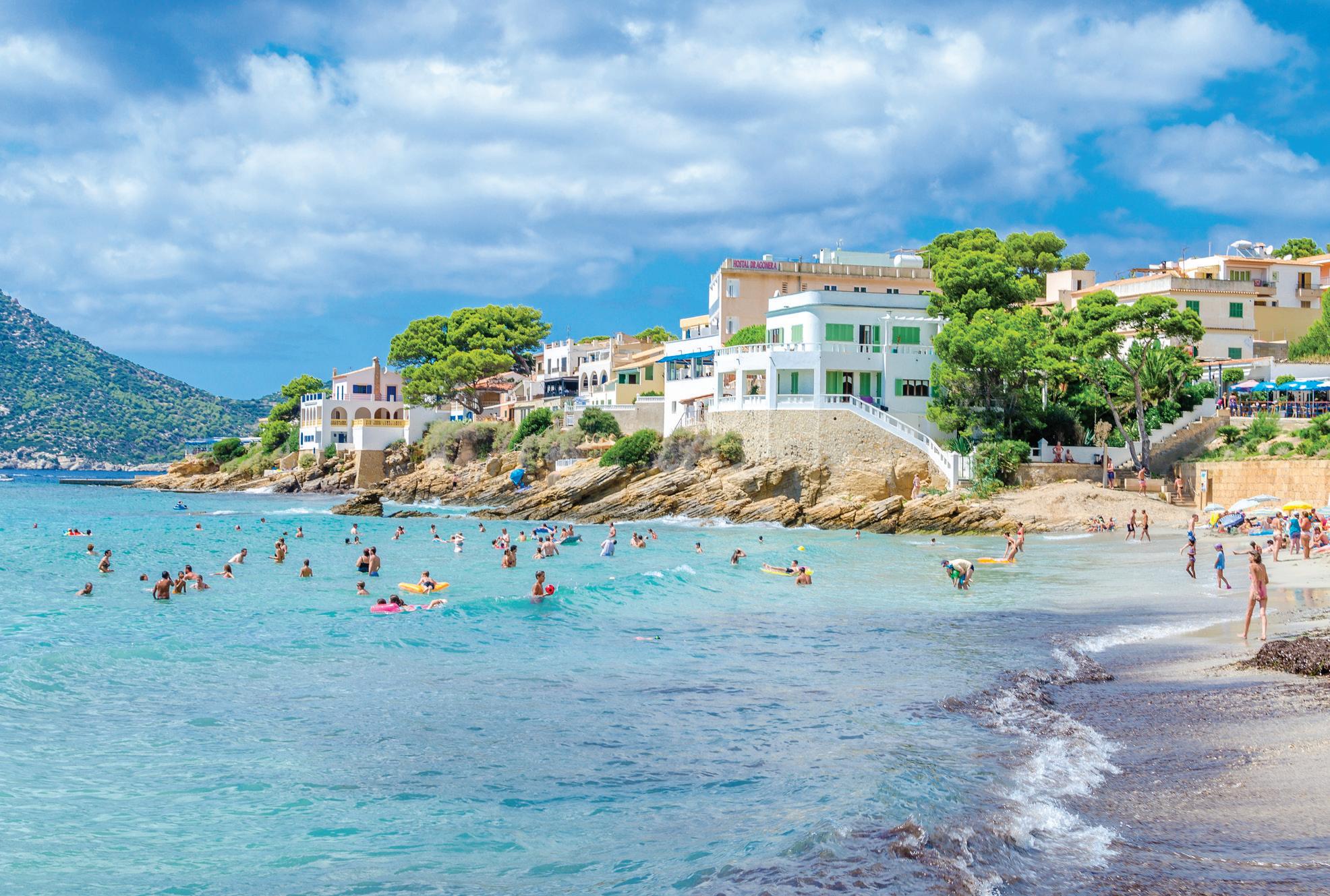
built in the 17th and 18th centuries. Prices also vary greatly by home type. An apartment can go for €800,000, while a luxury villa can command a price as high as €15 million.
Negotiations are common. “The vast majority of sellers assume a negotiating margin for the closing of the transaction,” Forteza said. “It is basically a buyer’s market, and nowadays it is more difficult for the seller to close a deal than it is for the buyer.”
Mallorca has many attractions, including the climate, “its beaches and mountains and above all the ability to live in a safe place that allows you to enjoy tranquility,” Forteza said.
If you are looking for tranquility close to Palma (the capital of both Mallorca and the Balearic Islands) and golf courses, Son Vida is a good choice, he said. “If you prefer to be close to beaches, we are inclined toward Bendinat or Portals Nous.”
If you are looking for a rural property, you have many options, he added.
Forteza expects “a relatively good year for luxury real estate in Mallorca,” he said. “The year started a little slow but we are now noticing an important increase in leads and therefore in the closing of transactions.”
His company, Berkshire Hathaway HomeServices Nova Mallorca, has more than 1,000 properties in its portfolio at the moment, Forteza said. The average number of sales per year is usually around 70 properties, both new and resale.•
Social media scrolling has changed the interior design game. Like what you see? Just screenshot it or save it for a future meeting with your builder or interior designer. Indeed, thanks to the global nature of apps like Instagram and Pinterest, a significant number of trends have rolled right out of a screen and into the vernacular of a neighborhood, no matter where it’s located.
Berkshire Hathaway HomeServices network professionals have observed an array of mini- and macro-design movements that continue to influence how homes are made, styled and updated. Certain color palettes are becoming more popular, some furniture styles are ubiquitous and specific styles of homes are appearing in new locations altogether.
For some design experts, social media images are a starting place for serious conversations about the reality and practicality of certain designs. Paul Hannan of Sala Architects in Minneapolis said this discussion with clients is a critical one. He tells his clients to “think in terms of the spaces required and the function of those spaces and how many people will be using those spaces on a daily basis.” What they create is a template for design, even globally inspired projects. “We focus on good design, reacting to the site and what it tells us and sustainable architecture.” And those are tenets that are important no matter the design trends.
On the next page, agents and design authorities explain what design trends they’re seeing and how it impacts their work and the landscape of real estate in their regions.
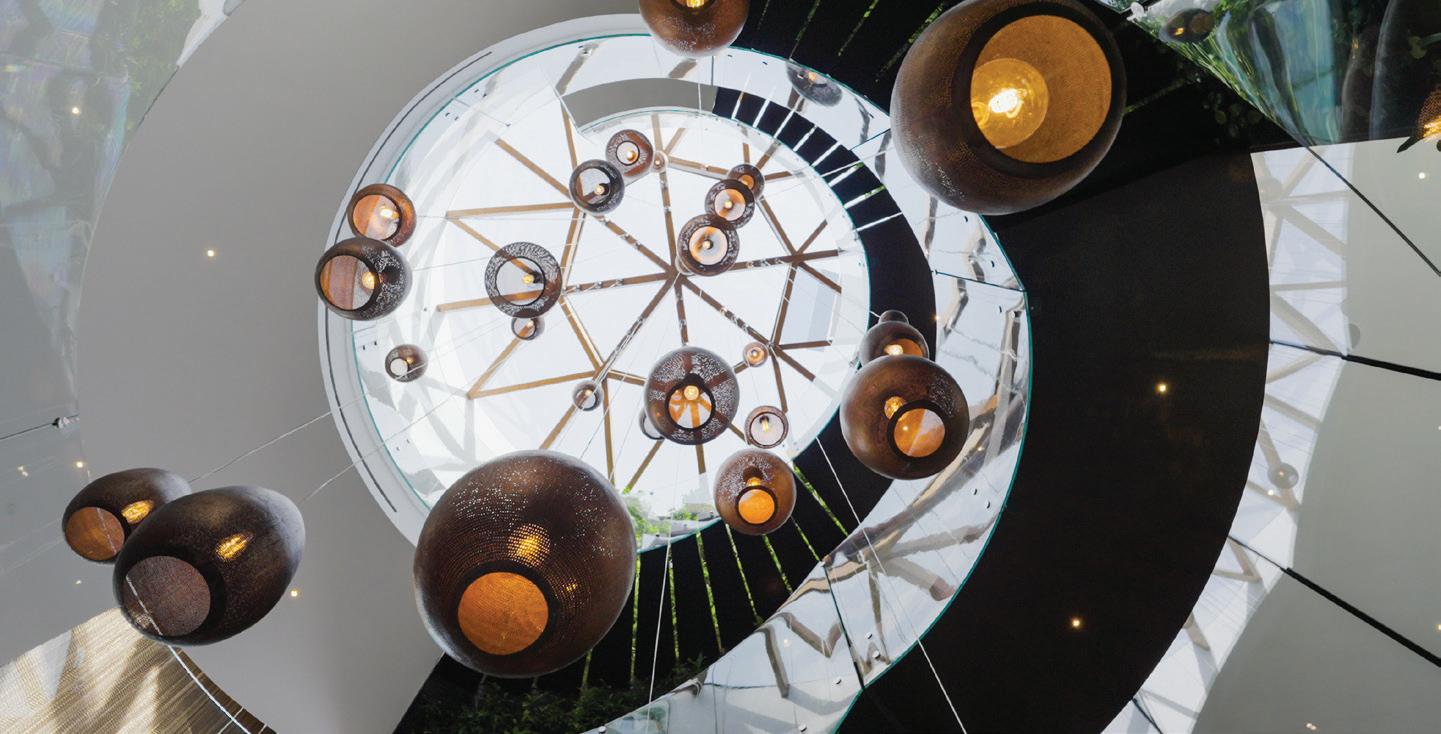

Thanks to social media all of a sudden you’re getting influence from Japan, Scandinavia and also different lines and different plays on beauty and perfection.”
Michael Vincent CEO and President Berkshire Hathaway HomeServices Portugal Property
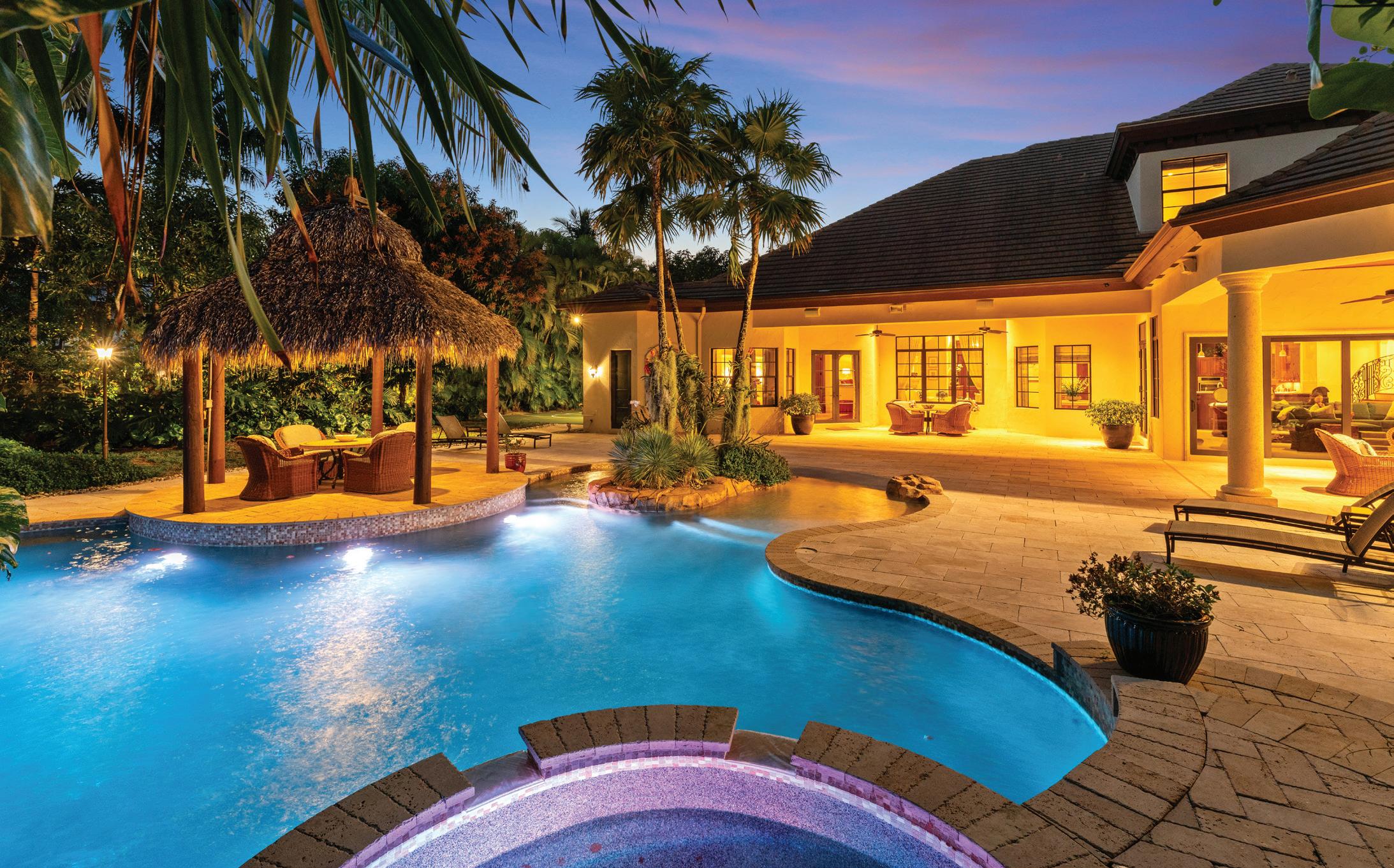
The white-box homes are less popular than they once were, with buyers all over the world appreciating warm spaces, often plant-filled, with color to boot. Michael Vincent, CEO and president, Berkshire Hathaway HomeServices Portugal Property, said that’s a trend he’s seeing across Portugal, and he credits it to social media. What consumers— about 40% of whom are from the U.S.—are craving now are more curves, timeless interiors and the beauty of imperfections, he said. “Thanks to social media all of a sudden you’re getting influence from Japan, Scandinavia and also different lines and different plays on beauty and perfection.” One property that embodies this is the Bailarina House in Quinta do Lago, the Algarve. “There’s not a straight line in the whole house,” Vincent said.
“The house is very alive with a garden and water features. It’s one of the most magical houses in the world.”
In more places than ever, high-end home buyers are yearning for spaces that afford a sense of peace and mindfulness. Understandably, the choice of natural materials, colors, softer lighting and the introduction of green spaces align with these criteria. “The traditional market is being affected by these trends, in new developments and driving the renovation of properties, where there is a great demand for natural light, outdoor spaces, energy efficiency and a connection with green spaces,” said Ana Lopes of Berkshire Hathaway HomeServices Atlantic Portugal in collaboration with Paula Arez, an architect and interior designer with
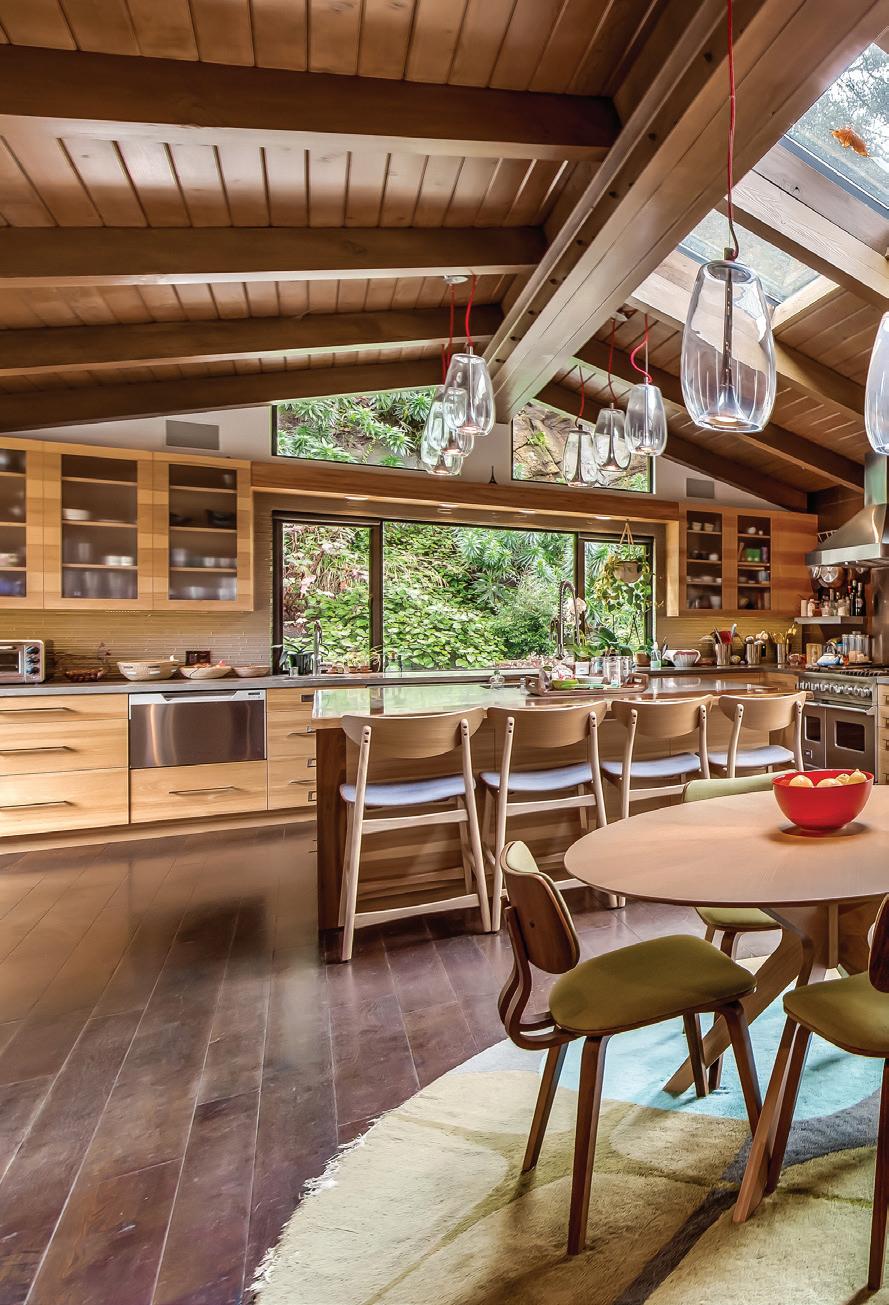
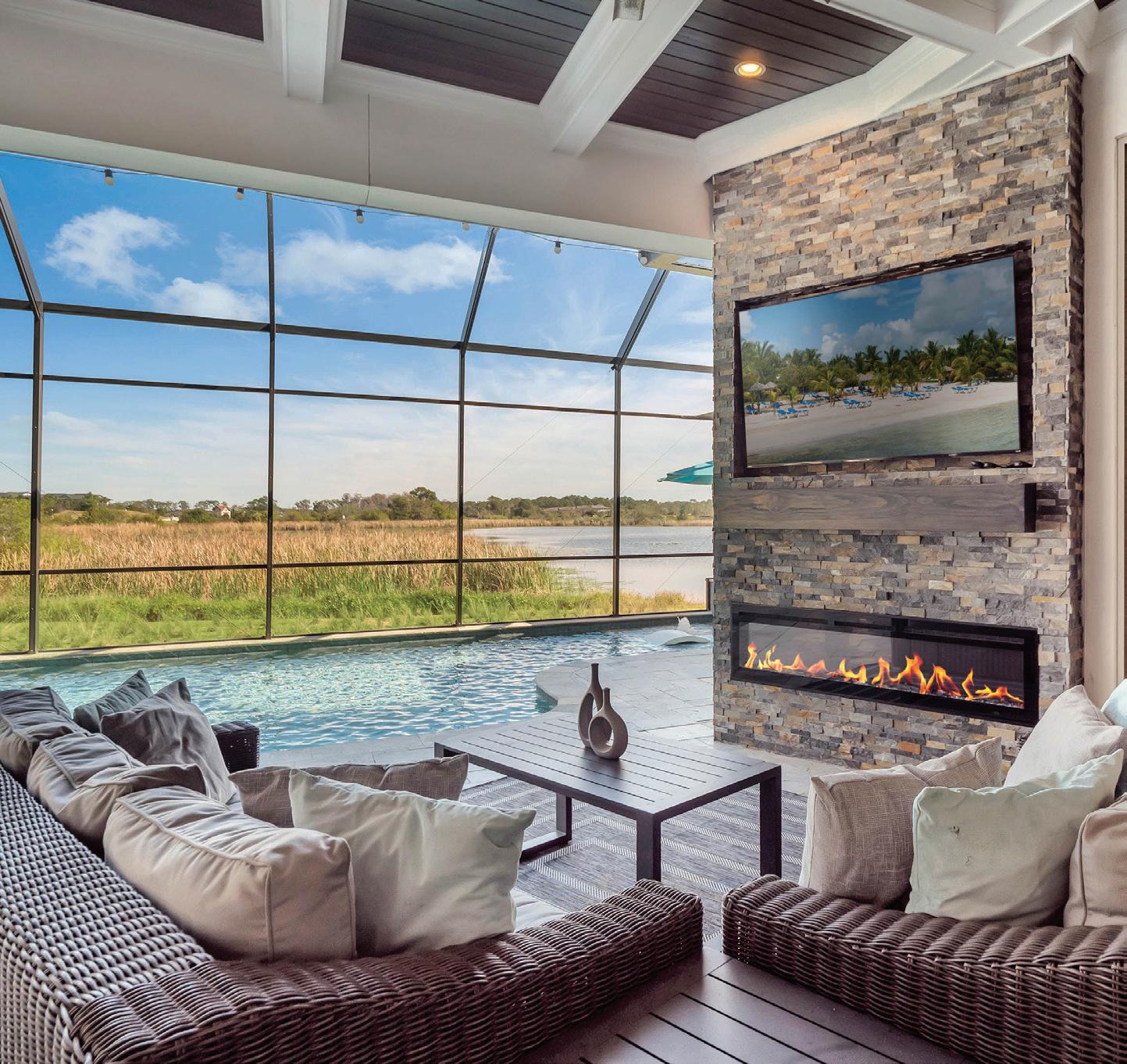
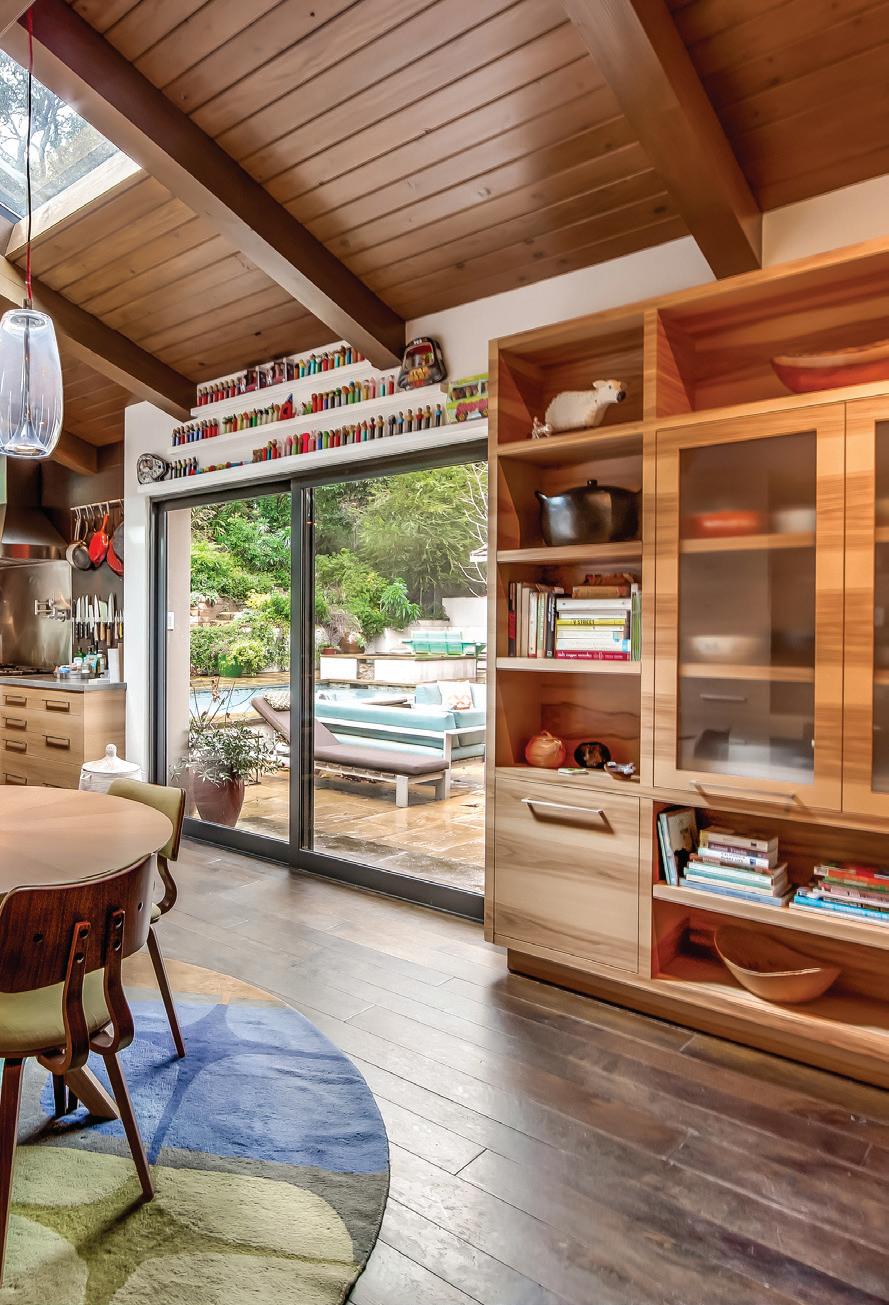
“The traditional market is being affected by these trends, in new developments and driving the renovation of properties, where there is a great demand for natural light, outdoor spaces, energy efficiency and a connection with green spaces.”
Ana Lopes Berkshire Hathaway HomeServices Atlantic Portugal
Idass Design. Two influences stand out today in Portugal, said Lopes and Arez, including the Brazilian architectural style with its popular characteristic of making a great connection between the exterior environment and nature, and the interior, creating almost limitless spaces between one and the other. The other is the architectural style of North Africa or Mexico, for example, with “rough” material solutions and earthy colors. “They are both styles that give us more comfort and peace, and for that reason, have staying power.”
The clean and traditional beach-chic style that prioritizes lifestyle and outdoor living is popular around the world. It’s perhaps no surprise that it’s this type of home that has set the tone for Florida’s 30A panhandle market. “Here, it’s about enhancing views of the Gulf of Mexico and preservation areas. Everything is designed around the scenery,” said Jimmy Burgess, CEO of Berkshire Hathaway HomeServices Beach Properties of Florida. Additionally, said Burgess, it’s about having a home with indoor-outdoor amenities, like a patio kitchen. One development, Kaiya, located in Inlet Beach, Florida, offers private villas, townhouses and condos within a luxe beachside community. And, the property prioritizes privacy where residences are often designed to back up to a pond or outdoor view. “You’re looking out over nature, not another set of houses,” he said.
The white paint trend has changed the design game, being used to makeover everything from antique interior woodwork to turn-of-the-century farmhouses. Yet in some regions, color still reigns. “New Orleans has always
marched to the beat of its own drum. We're not impermeable but we aren’t affected by big world trends,” said Jennifer Rice, managing partner and Luxury Collection Specialist who covers the greater New Orleans area for Berkshire Hathaway HomeServices Preferred, REALTORS®. Rice said homeowners will use white to freshen a look of a home, “but it will never take the place of color in New Orleans.” About 30 minutes north, however, white paint is modernizing the look of properties by bringing a lightening, brightening effect to older homes on the North Shore. A coat of white is helping these properties with reinvention, Rice said. “There’s nothing more beautiful than an older brick ranch style home overlooked for the last 50 years getting a face-lift on its brick. It becomes full of energy. The transformation is a joy to watch all over town.”
“The world has gone white on white on white, with the occasional black or accent wall,” added Forrest Barbee, designated broker, Berkshire Hathaway HomeServices Arizona Properties and Nevada Properties. This formula has become standard as buyers think about resale value down the road.
In Barbee’s West Coast U.S. region, and others around the globe, the desire for practical yet innovative floor plans is noteworthy. There’s been a notable switch, he said. Moving away from classic Tuscany style to desert contemporary “gives you more space, and allows for bigger and wider rooms,” he said. Before, homes built in Las Vegas in the 1960s and ’70s had multiple rooms and low ceilings. “That’s how we took care of energy efficiency back then. But now, you have more openness because your load bearing walls are done in a way to have bigger, wider spaces.”•
We asked Berkshire Hathaway HomeServices network members if their buyers want turnkey properties. Most do.
Source: Berkshire Hathaway HomeServices 2024 Global Luxury Landscape Market Report Survey. Do buyers want turnkey properties?
We asked our network members if the desire for turnkey properties has increased in the last year or so.
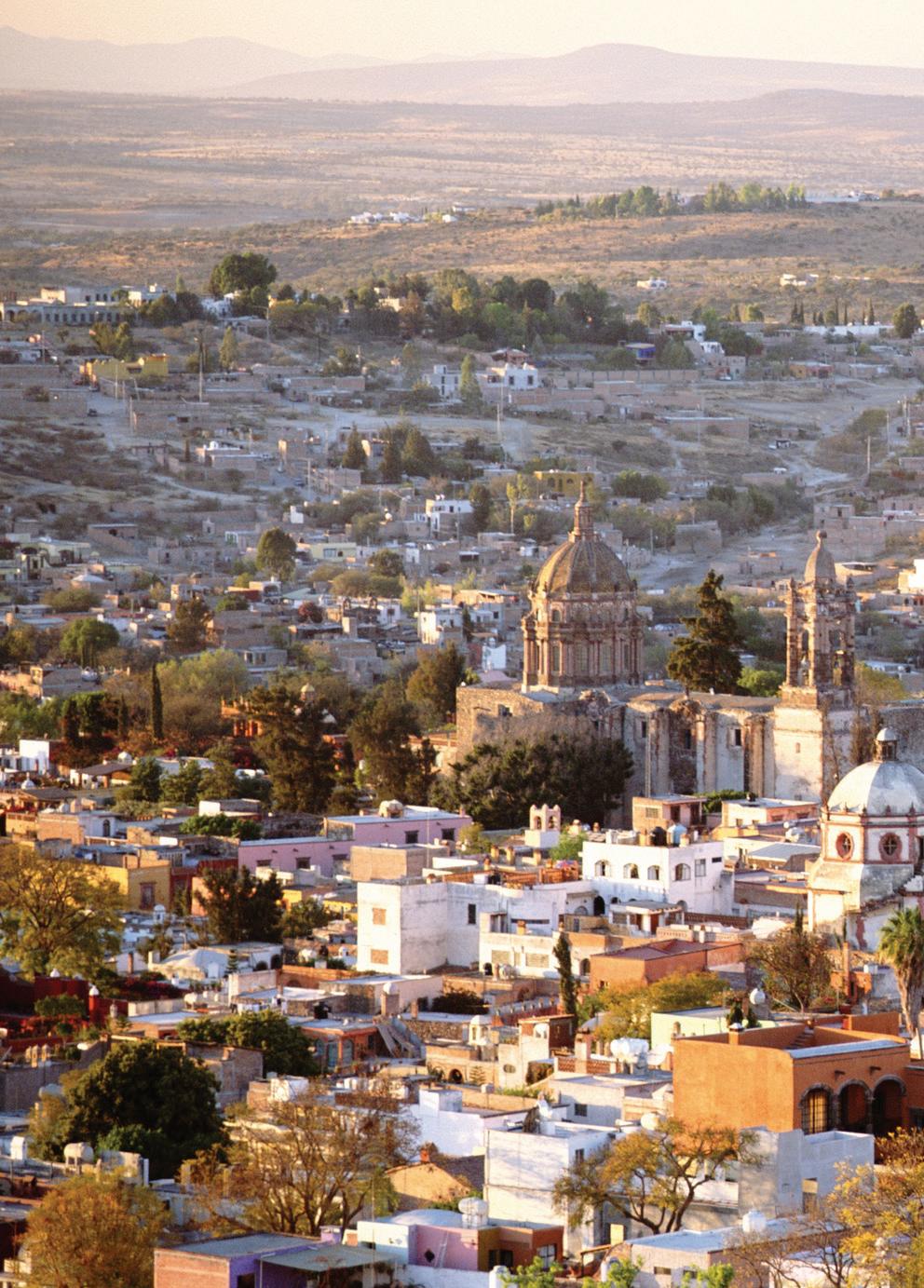
Source: Berkshire Hathaway HomeServices 2024 Global Luxury Landscape Market Report Survey.
To live in this picturesque colonial city in central Mexico is to step into the pages of a fairy tale. It’s easy to see why: You’ll find 480 years of well-preserved (and protected) Mexican Baroque and neoclassical architecture here along with a historic center that spans over 24 blocks. Add to this a cosmopolitan cultural scene and English language used throughout the city and it’s easy to see why San Miguel de Allende holds such a longstanding allure for foreigners and locals alike. Boasting the third largest population of American expatriates in Mexico, there’s a long history of Americans discovering the appeal of living in this UNESCO World Heritage
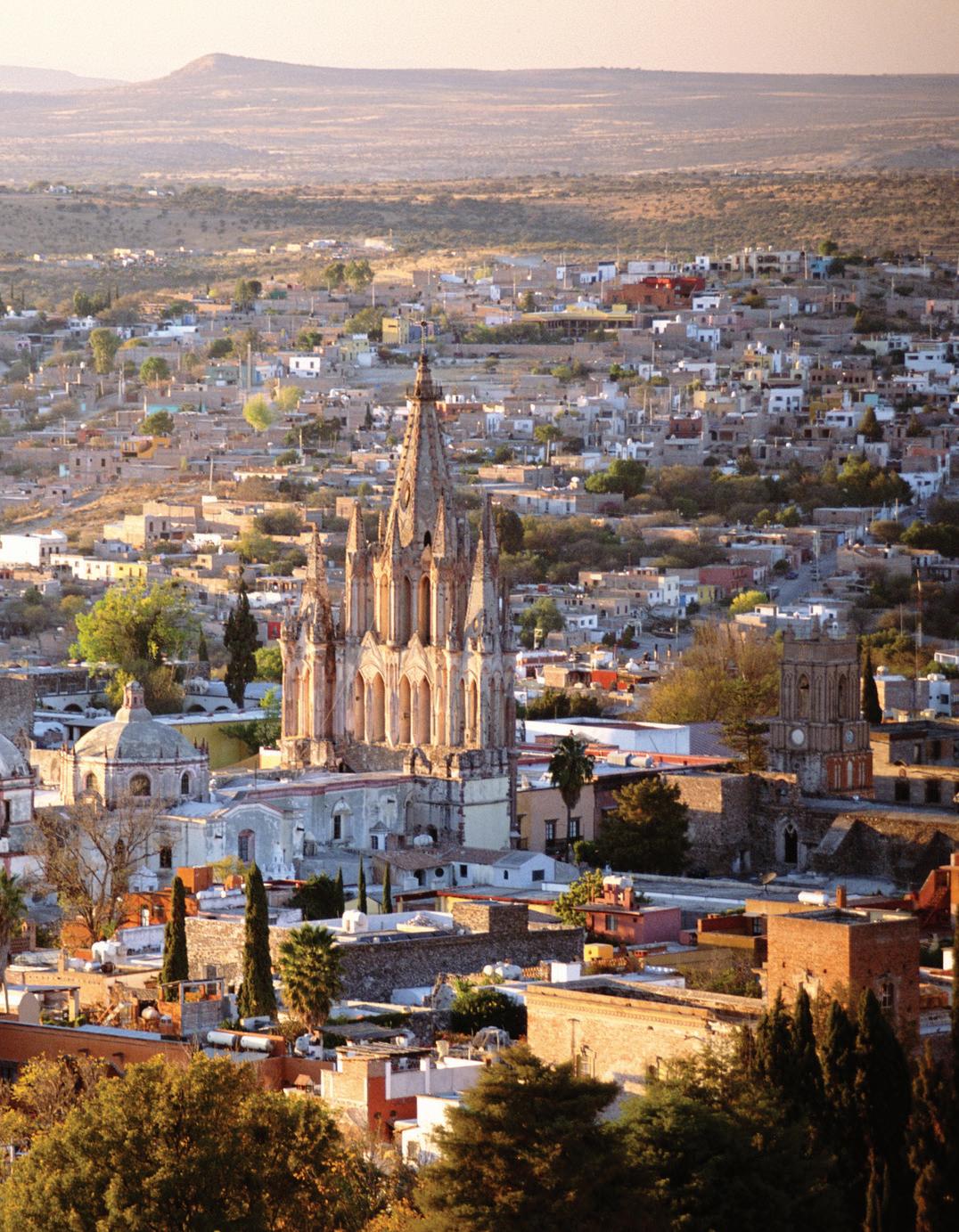
city even more interesting is that a $3 million home might be situated right next to one for $500,000,” said Greg Gunter, broker/owner at Berkshire Hathaway HomeServices Colonial Homes San Miguel, who moved to San Miguel 15 years ago. “That’s very common here.”
And, while nearly 40 seven-figure homes have sold here over the past three years, you can buy a substantial house for under $1 million and, on average, most single-family homes here start at $400,000, Gunter said.
“I’ve also got a golf course listing for $1.4 million and a nice home in a condo complex with new, modern amenities for the mid-$300,000s,” he said. “There are lots of possibilities here.”
site. Most point to the time right after World War II when an expatriate from Chicago became the director of the local art institute, with the goal of transforming San Miguel into an international arts colony.
To do so, he invited veterans to study here, with help from the GI bill, and before long, the idea of living here took off.
Starting then, the largest English language infrastructure in Mexico was established—and remains to this day. Cultural attractions such as concerts, opera and theater are all performed in English.
From Entry-Level to Super Luxury
The housing stock, here, is also quite diverse.
“What makes selling real estate in this
Nearly 150,000 people live in this city, beloved for its gently sloped cobblestoned streets, boutique hotels and galleries. San Miguel is one of the largest artist communities in the world.
Named the No. 1 small city in the world five times in a row by Condé Nast Traveler, San Miguel, considered the safest city in Mexico, features several churches—the most iconic is the “Parroquia” or the Church of St. Michael with its iconic pink ‘wedding cake’ spires—and over 500 restaurants, 50 of which are Michelin-starred.
“We’re like a small European village,” Gunter said. “You can walk everywhere. In fact, you can stroll across the entire length of the city center in about a half-hour.”
That said, San Miguel has 81 postal codes representing different neighbor-
hoods, many of which are anchored by one of the 27 churches dedicated to their patron saint, Gunter said.
Home buyers are drawn to three main neighborhoods. These include Centro, the center of town that’s anchored by the pink-spired “Parroquia” church; San Antonio, the largest of the city’s neighborhoods; and Guadiana, a gentrified neighborhood perched near the city’s second most popular park where homes range in price from $500,000 to $2 million.
Thanks to its 6,400-foot elevation in the high east Sierra Madre mountains, the city remains “high and dry” every single day, Gunter said.
“Our altitude keeps us very cool,” he said. “Even in the summertime, we cool down to the 60s so it’s rare to need air conditioning.”
While, in the past, San Miguel was typically favored by retirees and second-home buyers, the newcomer demographics have shifted younger in the past eight years, Gunter said.
“I sold a home last year to a 37-year-old Dutch couple who opened an art gallery here,” he said. “Six months ago, I sold a home to a Canadian couple in their early 40s.”
The most expensive, record-breaking listing in the city, however, is still for sale. Price: $6.995 million.
“It’s a Ricardo Legoretta-designed home,” Gunter said. “The only other one is in Los Angeles. It’s owned by [Hollywood producer] Joel Silver and it’s currently on sale for $49 million.”•

Wellness is a true buzzword, making a permanent mark in home design and decor.
These days, home dwellers increasingly want the next iteration of that— luxury homes that are biophilic, a term dubbed by the late Harvard naturalist Dr. Edward O. Wilson to describe humans’ innate desire to be close to nature.
“Biophilic design contributes to an indoor-outdoor connection between home interiors and their surrounding environment, which helps create healing, mindful spaces,” said interior designer Sarah Barnard of Sarah Barnard Design in Santa Monica, California.
We’ve all experienced the calming
effect of the ocean, and the invigoration of crisp, fresh mountain air, said Barnard. “It makes sense that we would want to maintain these pleasurable connections within our home environments and daily lives,” she said.
“The pandemic led many people to realize they needed fresh air, because they were stuck within the four walls,” said Sacha Brosseau, CEO of Berkshire Hathaway HomeServices Québec. “It was universal, no matter what city you lived in.”
Biophilic design includes everything from your outdoor space all the way to the textures on your sofa. “We study all of that,” said Tyler Jones, CEO and founder of Blue Heron design and
construction firm, which creates luxury homes, communities and interiors. The company has always focused on emotional and experiential effects of design, so biophilic concepts have become a logical next step. “Everyone is hyperfocused on wellness and longevity right now, and a lot of that can be incorporated into a well-designed home.”
Among the most popular features for the wellness-inclined are hot and cold therapy and sleep hygiene setups, said Jones. “Cold plunges next to hot tubs, steam rooms, dry saunas, infrared light therapy. Cryogenic therapies, hyperbaric chambers, sensory deprivation, meditation,” he said.
“Variations in lighting throughout a home can play a crucial role in controlling light levels and the overall mood of a space,” Barnard said. Motorized shades, smart glass and orienting furnishings toward outdoor views all work with outdoor light to help achieve the biophilic feel.
We have the technology to mimic what goes on in nature, said Jones, such as lighting to honor circadian rhythms, arranging total blackout, setting the room temperature for colder sleeping, and color temperature to emulate the warmth of the sun when rising and setting. “There’s a lot of science that goes into it,” Jones said. This affects your physiology and mood. “If you control that inside your house, you have the ability to help your body stay in tune with your sleeping and waking schedule to help you get the most optimized rest.”
Spa setups can create the feeling of retreat from negativity in the world, noted Ariana Lovato, owner and principal designer of Honeycomb Home Design. She sees the biophilic focus showing up most in primary bedrooms and bathrooms, which people view as their personal sanctuaries, while living rooms are for guests.
People also want to feel like their outdoor space is an extension of the indoors. “Accordion doors are a musthave in most of the doors we design, and it kind of doubles your living space,” Lovato said. “It gives that instant connectivity with your outdoors.”
Colors mimic natural surroundings, as do textures when it comes to biophilic design. “We have a really light white oak floor that’s trending, with a white plank, and white oak cabinetry that’s also very popular,” Lovato said. Black walnut, warm tones and quartzite
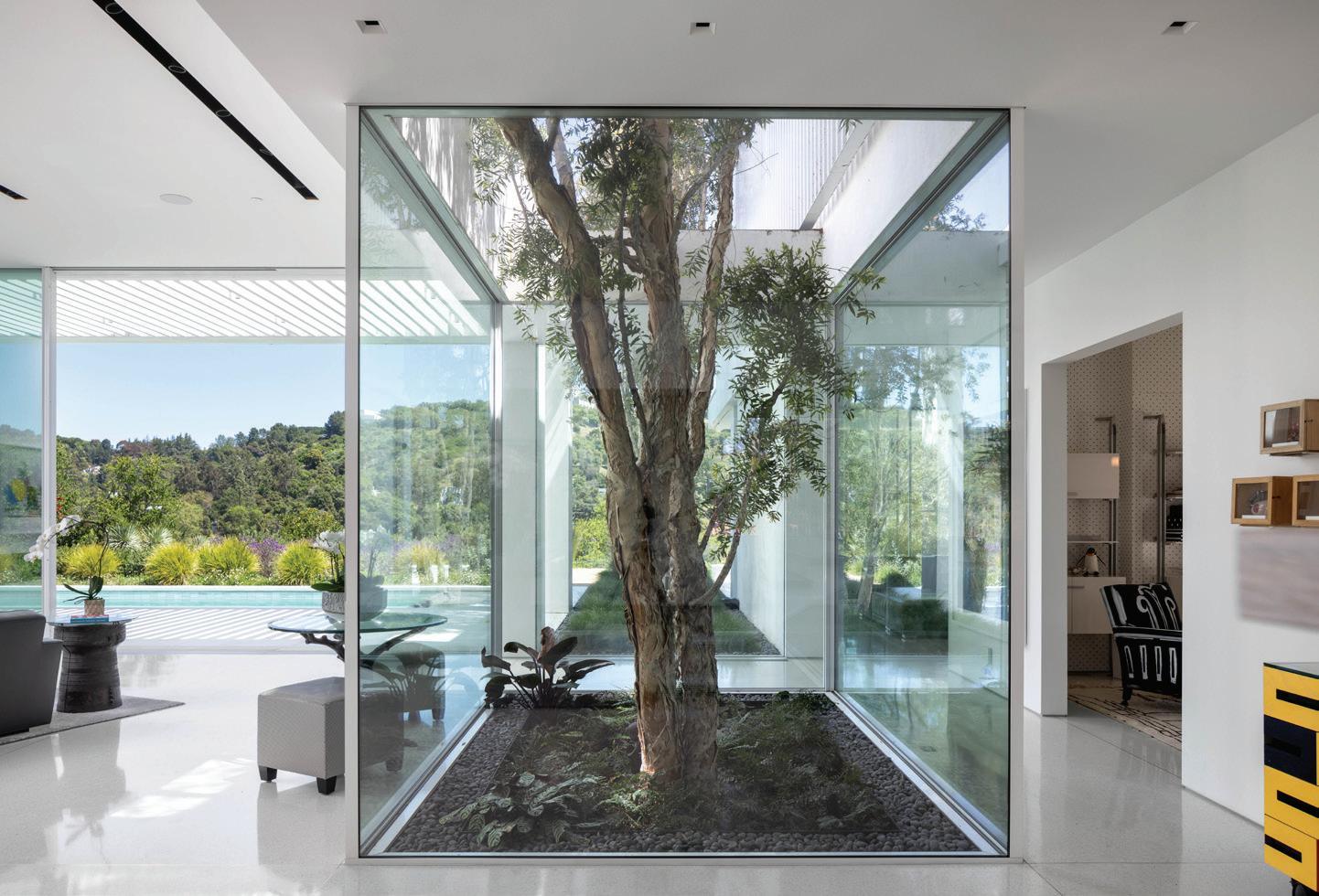
are also in high demand, she added. Jones noted that his company uses a lot of earth and desert tones, stone materials, organic wood and even fullscale trees. “We think of living plants as an actual material within our design palette. It really has a big impact on making you feel like you’re in the natural state.”
Indoor plants bring a host of wellness benefits. “The ritual of caring for living things is rewarding in itself, and the magic of watching plants grow and change reminds us that every day is, in fact, new,” Barnard said. They also detoxify the air.
Barnard recently designed an entryway for a 1949 storybook-style home in the Pacific Palisades with two bronze sconces depicting small bouquets of geranium leaves backlit for a warm glow. The dining room had a sculptural light fixture made of porcelain ginkgo leaves that appear to be gently blowing in the wind, with soft light filtering through the semitransparent porcelain. “The shape and lightness of the material create a poetic indoor-outdoor connection to the ocean nearby,” she said.
Homeowners are also embracing regenerative landscaping as a way to
Biophilic design
contributes to an indoor-outdoor connection between home interiors and their surrounding environment, which helps create healing, mindful spaces.”
Sarah Barnard
Sarah Barnard Design
Santa Monica, California
better connect with the environment. This includes planting native species to provide food and shelter for local wildlife and helpful insects; planting drought-resistant species (using less water and reducing runoff and soil erosion); improving conditions of existing soil to promote long-term sustainability; emphasizing low-maintenance vegetation; designing responsible irrigation systems; and creating outdoor spaces that merge with untamed surroundings.
“There is a powerful shift in more natural landscaping; people are taking notice,” said Jones. “This resonates deeply with our sense of well-being and belonging.”
This kind of landscaping creates flow between the home and the outdoors. “Using native plants within and outside the home promotes the seamless transition between built and natural spaces and supports local biodiversity and health,” Tyler said. “Native plants require less water and maintenance, aligning with the principles of regenerative landscaping.” He said the company is working on a project that even incorporates the crucial role hummingbirds play in regenerative landscaping by pollinating and supporting desert biodiversity.
Home dwellers are also celebrating nature themes in simple ways. “In Montreal, you can see a lot of Tuscanstyle kitchens with accents suggesting a lemon grove: lots of greens, lots of plants, touches of greenery as part of the design in the home,” said Brosseau.
This follows an environmental focus in commercial buildings, such as those that are Leadership in Energy and Environmental Design (LEED) certified and more efficient, said Mike Aubrey, executive vice president and principal at Mike Aubrey Group of Berkshire Hathaway HomeServices PenFed Realty. “People want to commune with nature more,” he said. “We’re seeing it in terms of how you’re putting those design elements into some of the older areas of design in order to not make it something that’s juxtaposed, but rather something that becomes homogeneous,” he said.
Design trends flow from commercial into residential, and retro commercial spaces are integrating green design elements into buildings, Aubrey said. “The exact same thing is going to happen with design on residential for people who are doing renovations as opposed to new builds. It’s really on the radar.”•

This artsy state capital, dubbed The City Different since the 1900s, has always been a place that has lured a wide variety of luxury homeowners. It’s likely because there’s so much to experience here, whether you’re an outdoor enthusiast or history buff, culture lover or foodie seeking spice via chilies, New Mexico’s state vegetable, which is featured in many of the 400-plus restaurants and bars.
One of the major cultural destinations in this city, the Georgia O’Keeffe Museum, is located downtown, and the gallery scene throughout the town is worldrenowned. And it’s no wonder, as this eclectic city, a blend of New Age and Southwest spirit, offers a wide variety of immersive art experiences in its 250-plus galleries.
As for what you’ll find among homes for sale, the offerings include plenty of adobe, stucco, brick and wooden homes, but Santa Fe has also recently been deemed the “mecca of modern architecture,” thanks to many all-glass modern homes with breathtaking views.
Neighborhood by Neighborhood Within the luxury market, there are four neighborhoods considered the most desirable, said Jim Pitts, president of Berkshire Hathaway
HomeServices Santa Fe Real Estate.
These include the Historic Eastside neighborhood (known for its low-slung centuries-old adobe homes); the Northwestern corridor, including Las Campanas (a community that features newer homes, which start at around $600,000, with larger lots and rolling hills); the village of Tesuque, where you can expect to find multimillion-dollar estates that blend vintage adobe and Territorial Revival styles and are set behind gates; and Southeast Santa Fe, which offers golf communities and large equestrian ranches and is perched between the Eastside and the foothills of the Sangre de Cristo Mountains.
Home prices often skew lower than comparable ones you’d find listed in other states, Pitts said.
“Some of the people that are priced out of resort markets in Colorado are coming here,” Pitts said. “While it’s $12 million to buy a place in Aspen, you can buy that same house here for $2 million and you still have hiking, skiing, great restaurants, the history—everything you could want.”
With four temperate seasons—it’s sunny here 320-plus days of the year— indoor/outdoor living, hiking, biking and golfing are easy to do almost every single day.
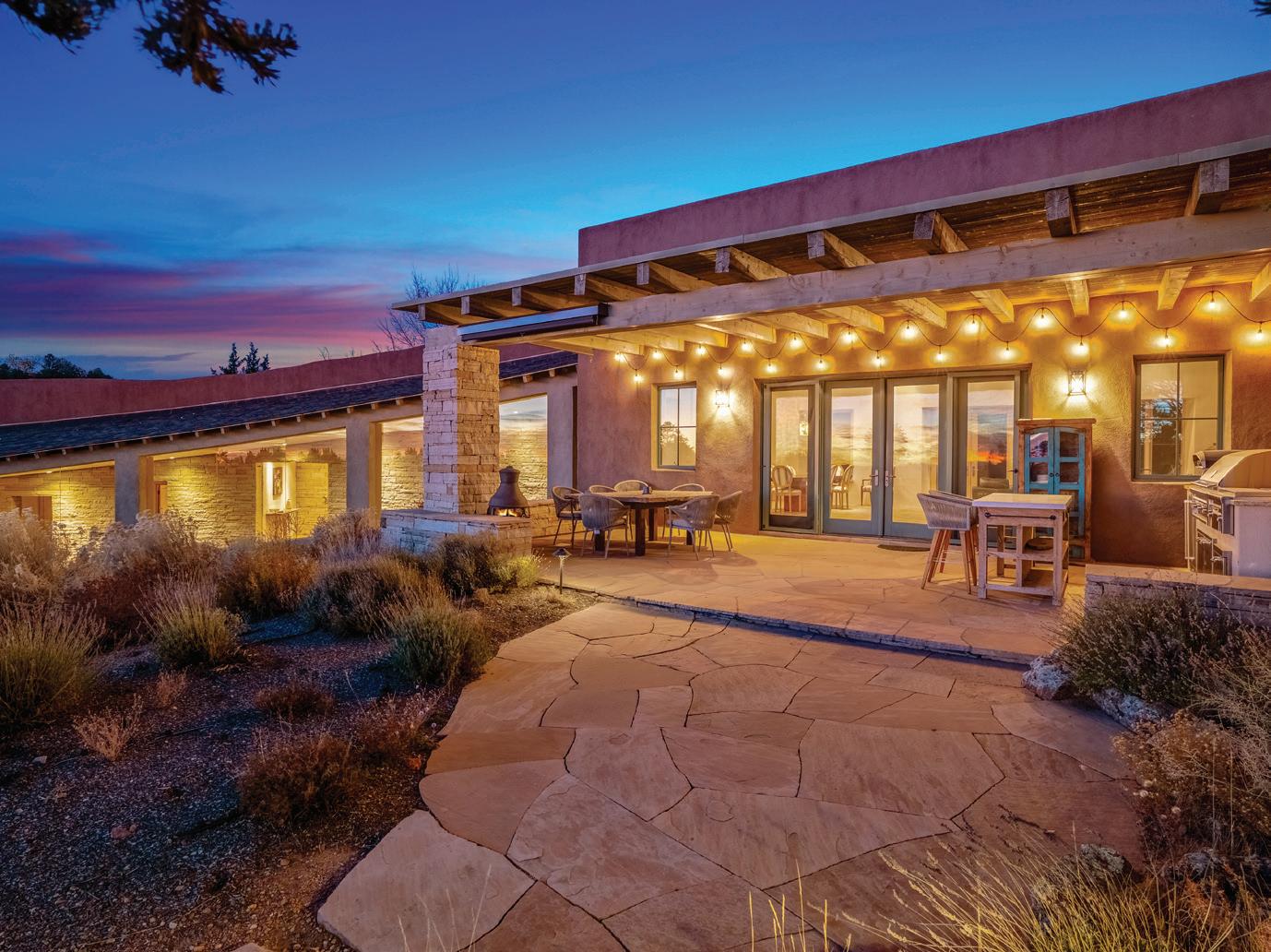
Historically, Santa Fe has been a particularly attractive place for retirees to move to full-time or purchase second homes, said Mark Rochester, vice president of Berkshire Hathaway HomeServices New Mexico.
“We don’t have a great deal of industry here so the primary demographic that moves is older,” he said, adding that new homeowners tend to be moving here from such locations as the Northwest, Northeast, Texas and California.
This may be changing, however, with the increased number of films being shot here.
“We’ve become a hub for movies and TV shows,” Pitts said. “Every day you see the signs for movie shoots and we have actors in town all the time. A lot get here and say ‘maybe I want to buy something here.’”
And, with Santa Fe Regional Airport currently undergoing renovations, and flights daily on United and American from Denver, Dallas, Houston and Phoenix, the city is soon going to be even easier to access for home buyers. For those seeking international flights, the Albu-
querque airport is located less than an hour away.
At present, there’s a flurry of activity in the market of homes at a higher price range, which, in Santa Fe, is between $2.5 million and $5 million, Rochester said.
“This is simply because the majority of those buyers are cash buyers,” said Rochester, adding that this number has risen of late, including a home he recently sold for $7 million. “The higher end is very active right now.”
In addition, both Pitts and Rochester predict an increase in inventory and in sales as we move into next year.
“Santa Fe has all of the amenities of a high-end market, but you can buy a house here for much less than a home in a high-end resort market,” Pitts said. “Santa Fe and New Mexico overall is a little bit of an undiscovered, affordable place to have a beautiful, luxurious home.”•